Dental material practical
1/38
There's no tags or description
Looks like no tags are added yet.
Name | Mastery | Learn | Test | Matching | Spaced |
|---|
No study sessions yet.
39 Terms
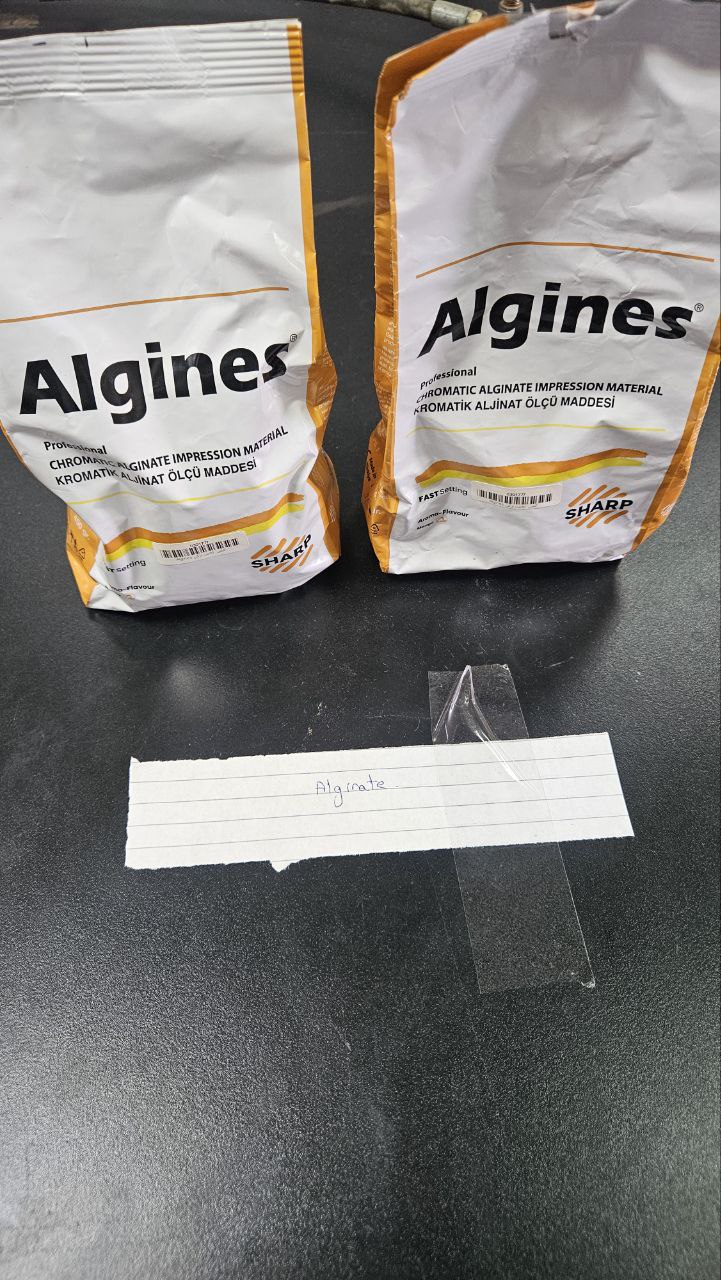
Alginate
Advantages of Alginate:
Inexpensive.
Easy to mix and use.
Hydrophilic (works well in wet environments).
Disadvantages of Alginate:
Tears easily.
Poor dimensional stability (must pour quickly).
Lower detail reproduction (bad for crowns and bridges).
Uses of Alginate:
Primary impressions for dentures.
Diagnostic models.
Making night guards and fluoride trays.
Properties of Alginate:
Flexible and elastic (easy removal).
Poor tear strength.
Dimensionally unstable if not poured quickly.
Manipulation of Alginate:
Mix powder with water in a rubber bowl using a spatula.
Load quickly into a perforated or rim-lock tray.
Insert in mouth while in sol (liquid) state and remove after it gels.
Name of the Setting Reaction:
Chemical cross-linking reaction (sol → gel transformation).
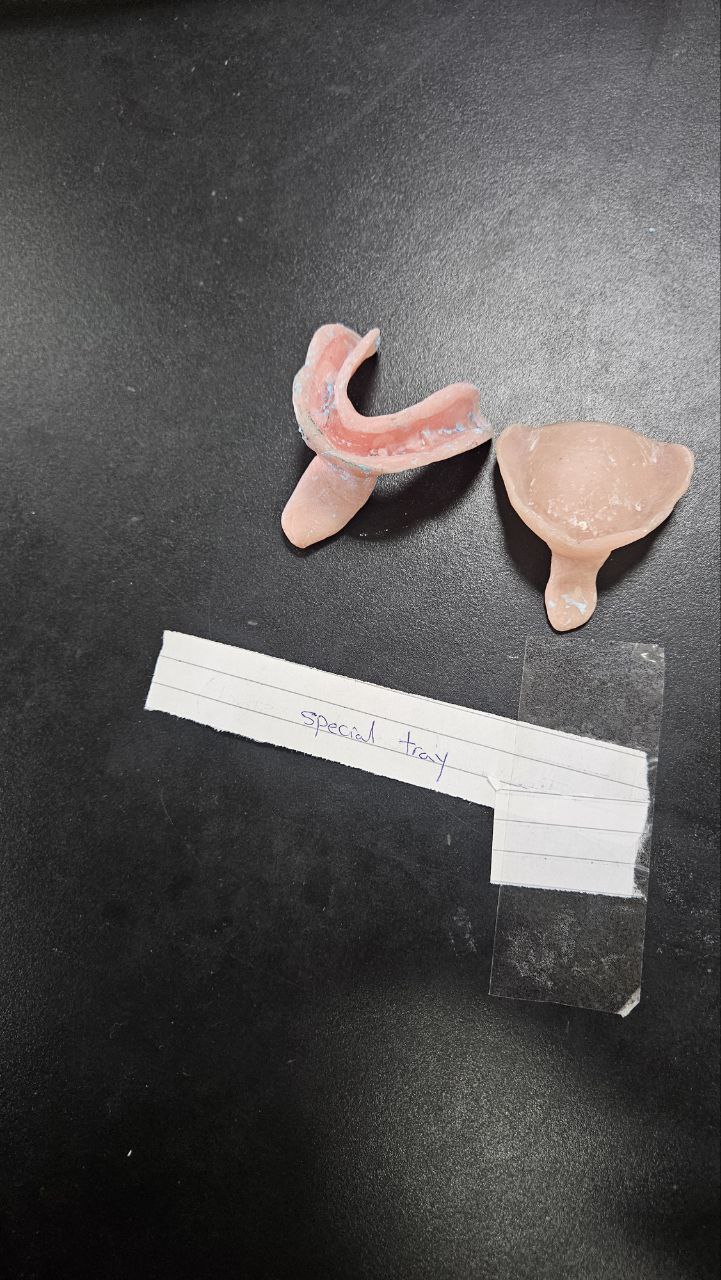
Special tray
Advantages of Special Tray:
Better fit to the patient’s mouth (customized).
More accurate impressions (better detail).
Reduces material thickness (less distortion).
Disadvantages of Special Tray:
Time-consuming (needs extra step to make it).
More expensive than stock trays.
Needs laboratory work (can’t use immediately).
Uses of Special Tray:
Final impression for complete dentures.
Crowns and bridges impressions.
Impressions needing high accuracy.
Properties of Special Tray:
Rigid and strong.
Custom-made to fit each patient individually.
Controls the thickness of impression material.
Manipulation of Special Tray:
Make a primary impression first using alginate.
Fabricate special tray on the primary cast (using acrylic usually).
Use the special tray to take the final impression

Stock tray
Advantages of Stock Tray:
Ready-made in different sizes — no need to fabricate.
Saves time — can be used immediately.
Inexpensive compared to custom trays.
Disadvantages of Stock Tray:
Not a perfect fit to every patient.
More impression material needed (thicker layer = more distortion).
Less accurate for fine details.
Uses of Stock Tray:
Primary impressions for dentures.
Diagnostic models.
Opposing arch impressions.
Properties of Stock Tray:
Comes in metal or plastic types.
May have perforations or rim-locks to retain material.
Must be rigid to avoid distortion during impression.
Manipulation (in Alginate Use):
Select appropriate size tray (should cover all teeth and tissues).
Load alginate into tray after mixing.
Seat tray in patient’s mouth firmly but gently

Dental compound impression material (green sticks and cakes (sheets))
Advantages:
Easy to manipulate when heated.
Can be reused if needed (reversible).
Good for border molding and edentulous impressions.
Disadvantages:
Poor reproduction of fine details.
Rigid after setting (can fracture if undercut).
Requires external heat source to soften.
Properties:
Thermoplastic (softens when heated, hardens when cooled).
High viscosity when molten (mucocompressive).
Rigid after cooling.
Manipulation:
Heat compound over flame or in hot water.
Knead until uniform and soft.
Seat in mouth and allow to cool and harden.
Uses of green stick compound:
Border molding of custom trays.
Minor adjustments in impression extension.
Peripheral seal creation in dentures.
Uses of sheets cakes compound:
Primary impressions for edentulous arches.
Making special tray outlines.
As spacer material in denture impressions.
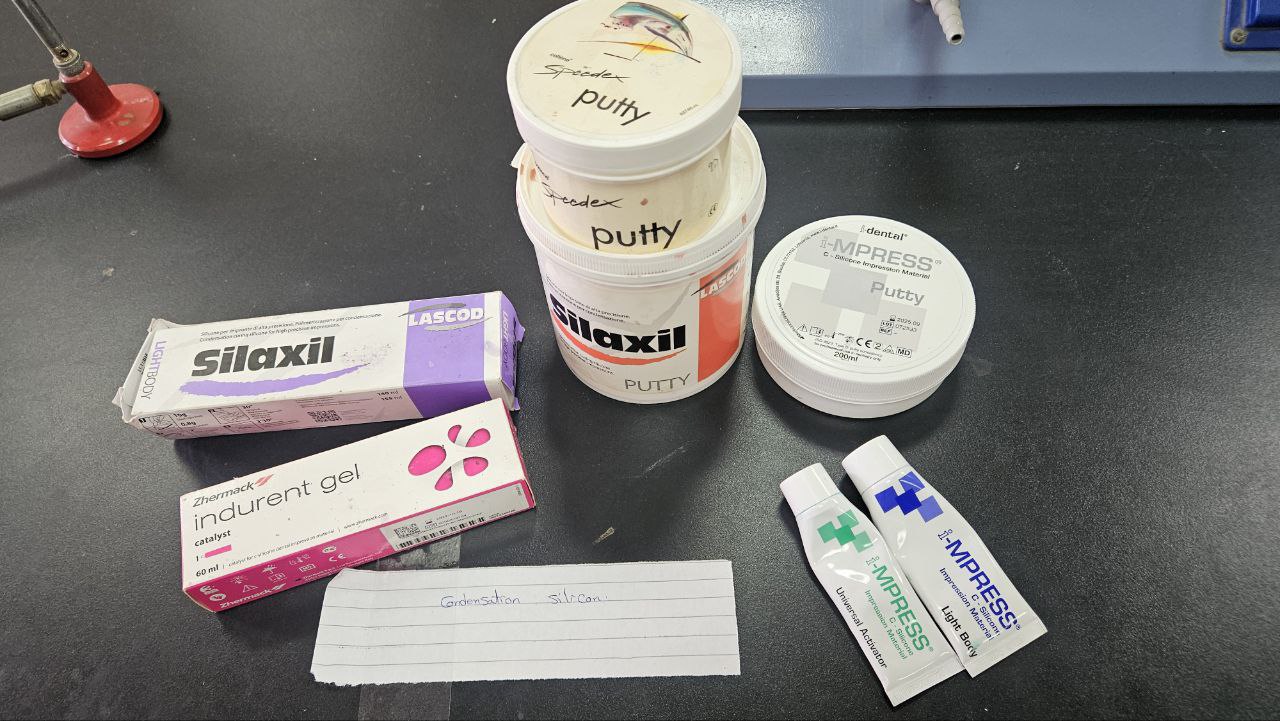
Condensation silicon
Advantages:
Good elastic recovery (returns to shape after removal).
Acceptable working and setting times.
Pleasant taste and odor for the patient.
Disadvantages:
Dimensional instability over time (releases alcohol after setting).
Requires immediate pouring of the cast.
Sensitive to proper mixing proportions (if wrong = bubbles or poor results).
Uses:
Final impressions for crowns and bridges.
Impressions for removable partial dentures.
Opposing arch impressions in restorative work.
Properties:
Hydrophobic (does not like moisture).
Good flexibility but poor wetting of oral tissues.
Undergoes polymerization shrinkage due to by-product (alcohol loss).
Manipulation:
Mix base paste and catalyst paste properly.
Load into tray quickly and insert into mouth.
Allow to set, then remove carefully.
Name of Setting Reaction:
Condensation polymerization (alcohol is released as a by-product).

Glass slab and cement spatula
Glass Slab
Unique Points:
Used to mix materials that are sensitive to temperature (e.g., zinc phosphate cement) — the cool slab slows down the setting.
Provides a non-stick, smooth surface ideal for mixing cements.
Easy to clean and reusable, made from thick, polished glass.
Cement Spatula
Unique Points:
Flexible stainless steel blade — allows smooth mixing without tearing or cutting the material.
Specifically designed for hand mixing of dental cements (like glass ionomer, zinc phosphate, polycarboxylate).
Different sizes available depending on the type of cement and quantity being mixed.
Easy Way to Memorize:
Glass Slab → Cool, Smooth, Reusable
Cement Spatula → Flexible, Mixer, Size-varied
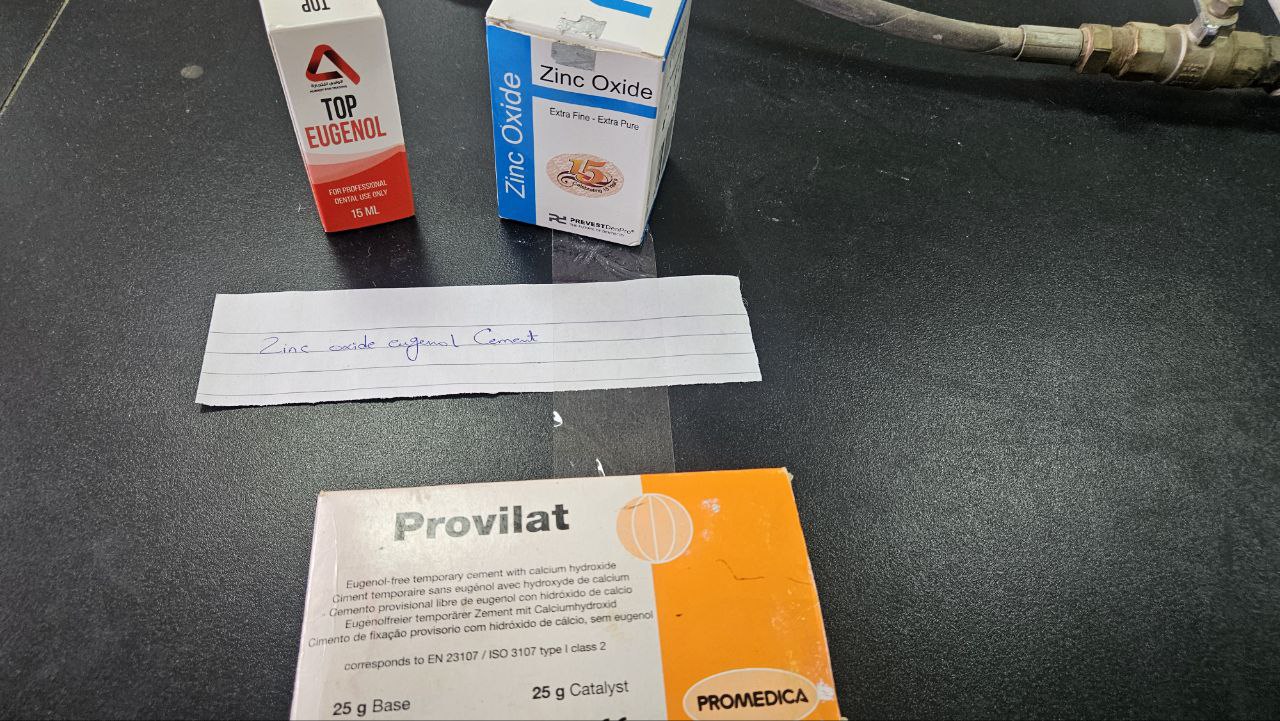
Zinc oxide euginol cement
Advantages:
Very soothing (sedative) effect on the pulp.
Good sealing ability (prevents leakage).
Easy to mix and manipulate.
Disadvantages:
Low strength (not suitable for permanent restorations).
Soluble in oral fluids (can wash away over time).
Can interfere with resin restorations (inhibits polymerization).
Uses:
Temporary cementation of crowns and bridges.
Temporary fillings.
Base material under non-resin permanent restorations.
Properties:
Sedative effect due to eugenol content.
Low compressive strength compared to other cements.
Good marginal seal but poor long-term durability.
Manipulation:
Mix powder (zinc oxide) and liquid (eugenol) on a mixing pad or glass slab.
Achieve creamy consistency for luting, thicker for temporary filling.
Load quickly before setting and apply.
Name of Setting Reaction:
Acid-base reaction between zinc oxide (base) and eugenol (acid).
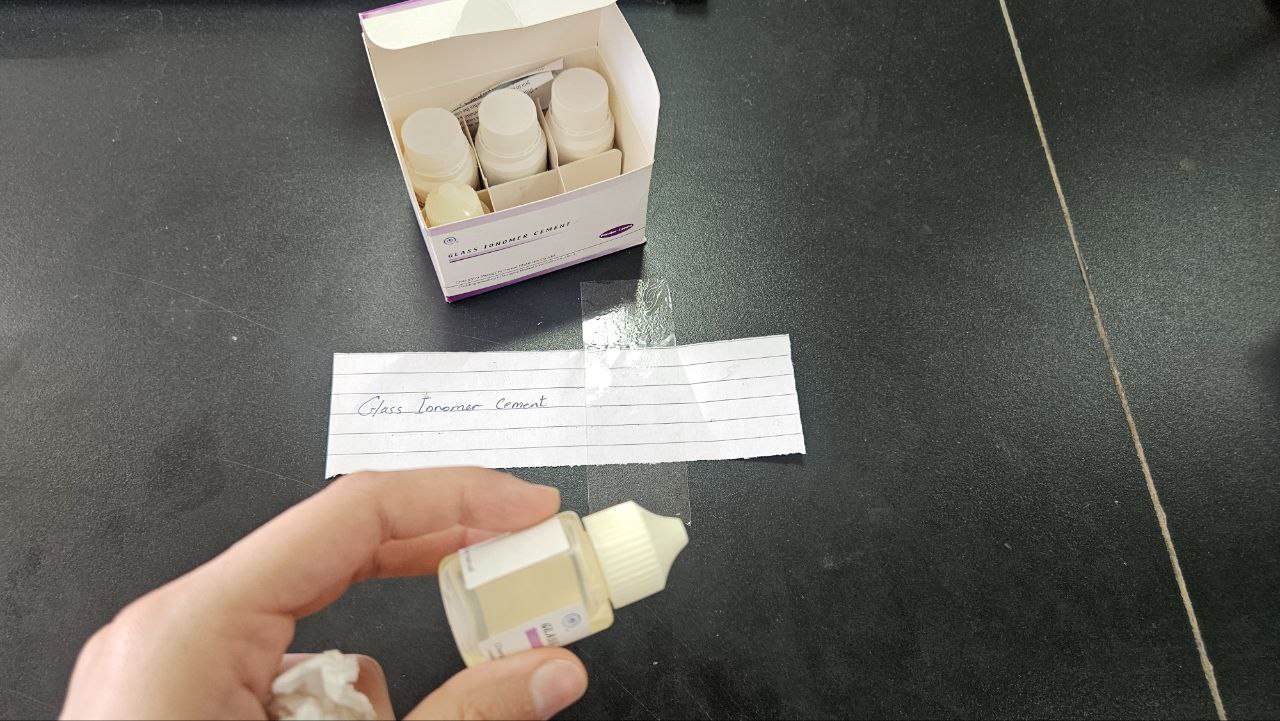
Glass ionomer cement
Advantages:
Chemically bonds to enamel and dentin without a bonding agent.
Releases fluoride over time (helps prevent caries).
Good biocompatibility with tooth tissues.
Disadvantages:
Moisture sensitive during early setting (can wash out or weaken).
Brittle — low fracture resistance compared to resin materials.
Rougher surface finish (needs protection or coating).
Uses:
Luting (cementing) crowns and bridges.
Base or liner under restorations.
Restorations in non-stress areas (like class V lesions).
Properties:
Chemical adhesion to tooth structure (no need for etch & bond like composite).
Fluoride release (anticariogenic effect).
Low tensile strength and higher brittleness compared to resin.
Manipulation:
Mix powder and liquid on a mixing pad or glass slab.
Apply to cavity or prosthesis quickly before it sets.
Protect early with varnish or resin coating to prevent moisture contamination.
Name of Setting Reaction:
Acid-base reaction between glass powder (base) and polyacrylic acid (acid).
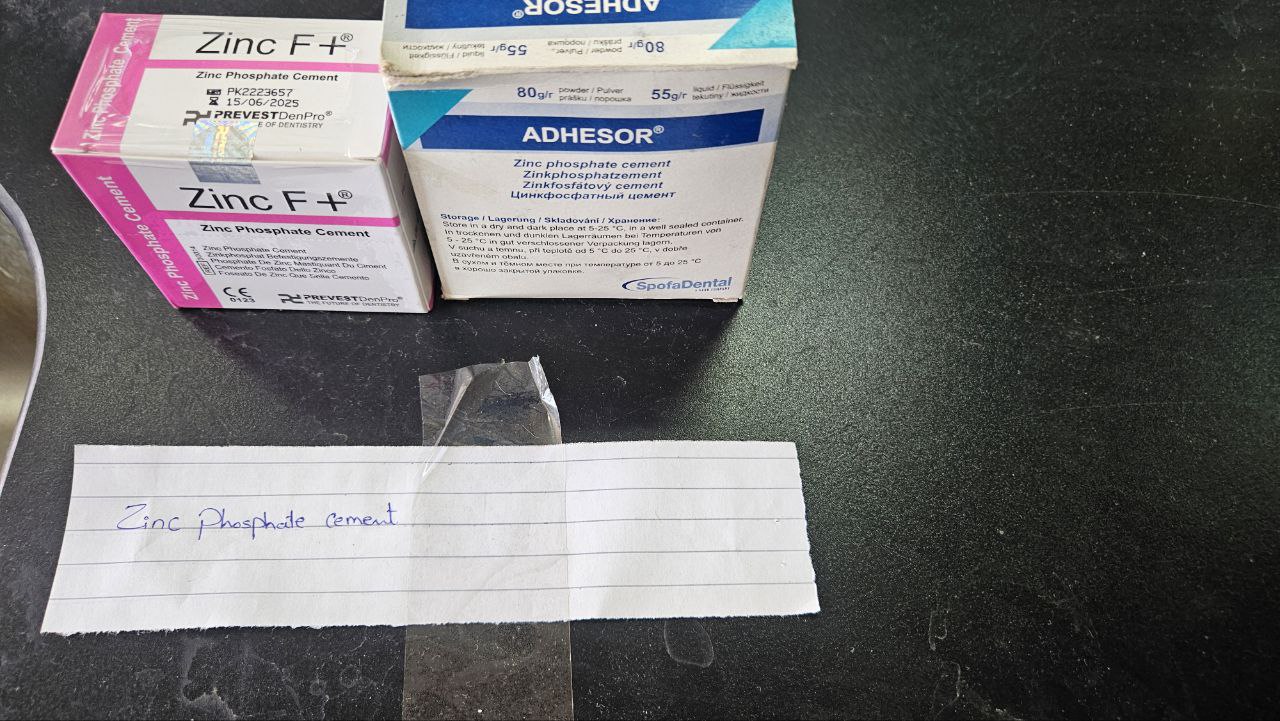
Zinc phosphate cement
Advantages:
High compressive strength (good support under restorations).
Long clinical history — proven reliability.
Good thin film thickness (excellent for crown seating).
Disadvantages:
Low pH when freshly mixed → can irritate the pulp.
No chemical bond to tooth structure (only mechanical retention).
Technique-sensitive — must control temperature during mixing.
Uses:
Luting agent for crowns, bridges, and orthodontic bands.
Base material under metallic restorations.
Temporary restoration in some cases.
Properties:
Strong in compression but weak in tension.
Sets by acid-base reaction (exothermic).
Low initial pH — becomes neutral over time.
Manipulation:
Mix powder and liquid on a cool glass slab to control setting and exothermic reaction.
Add powder slowly in small increments into the liquid.
Use quickly after mixing before it thickens.
Name of Setting Reaction:
Acid-base reaction between zinc oxide (base) and phosphoric acid (acid).
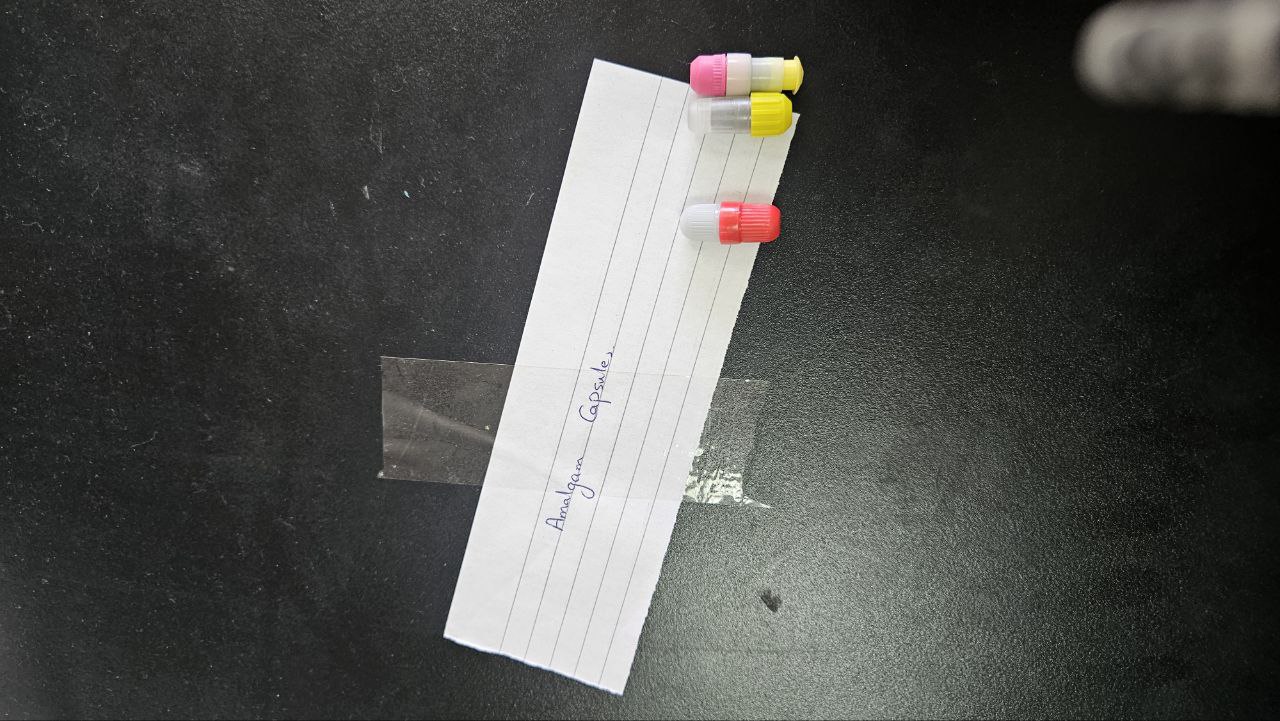
Amalgam capsule
Advantages:
Premeasured mercury and alloy → ensures correct mixing ratio.
Hygienic — reduces mercury exposure risk.
Easy and fast to use with amalgamators (mechanical mixers).
Disadvantages:
Cannot adjust the mercury/alloy ratio manually.
Extra cost compared to hand mixing.
Single-use — generates more waste.
Uses:
Used for automatic mixing of dental amalgam in an amalgamator.
Safe preparation of amalgam for fillings.
Reduces mercury handling in dental offices.
Properties:
Sealed container with two compartments (one for mercury, one for alloy powder).
Breakable membrane inside — allows mixing when activated.
Available in different sizes depending on the amount of amalgam needed.
Manipulation:
Shake or press the capsule to break the internal membrane.
Place the capsule into an amalgamator for mechanical mixing.
Open capsule and load mixed amalgam into carrier for placement.
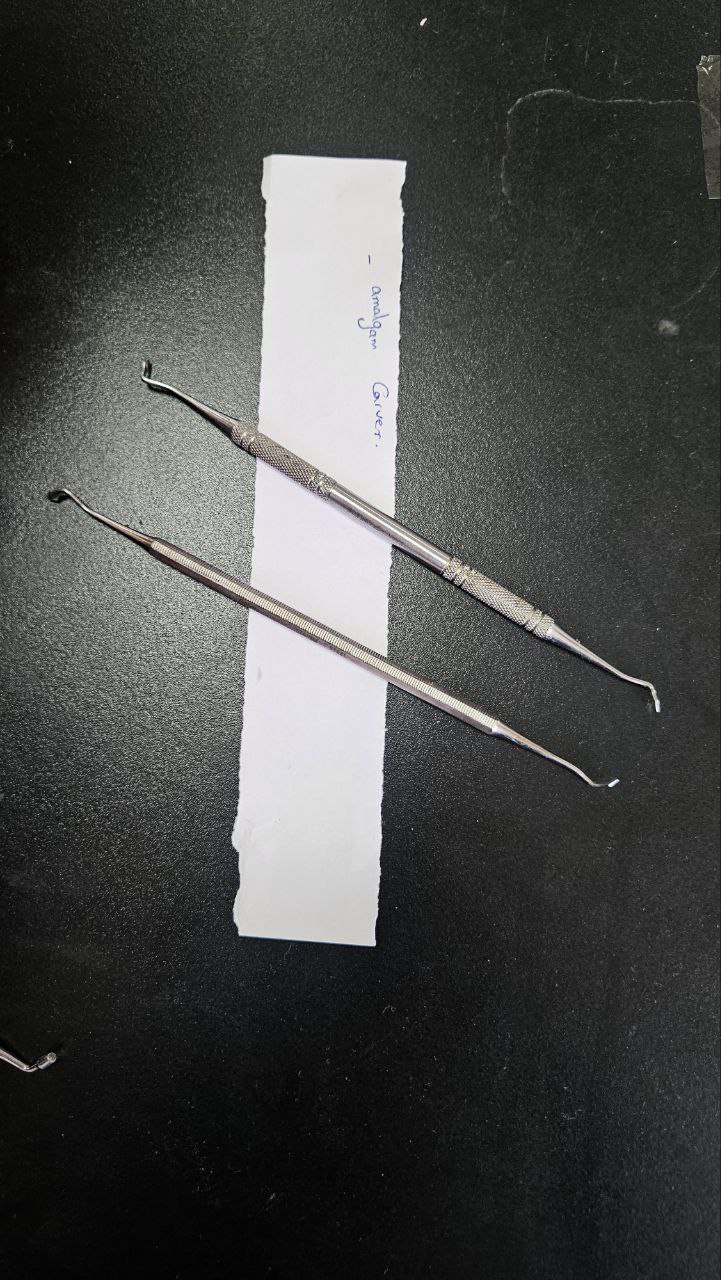
Amalgam carver
Amalgam carver: shapes and smooths fresh amalgam.
Shape: thin, sharp, pointed or blade-like ends, usually double-ended.
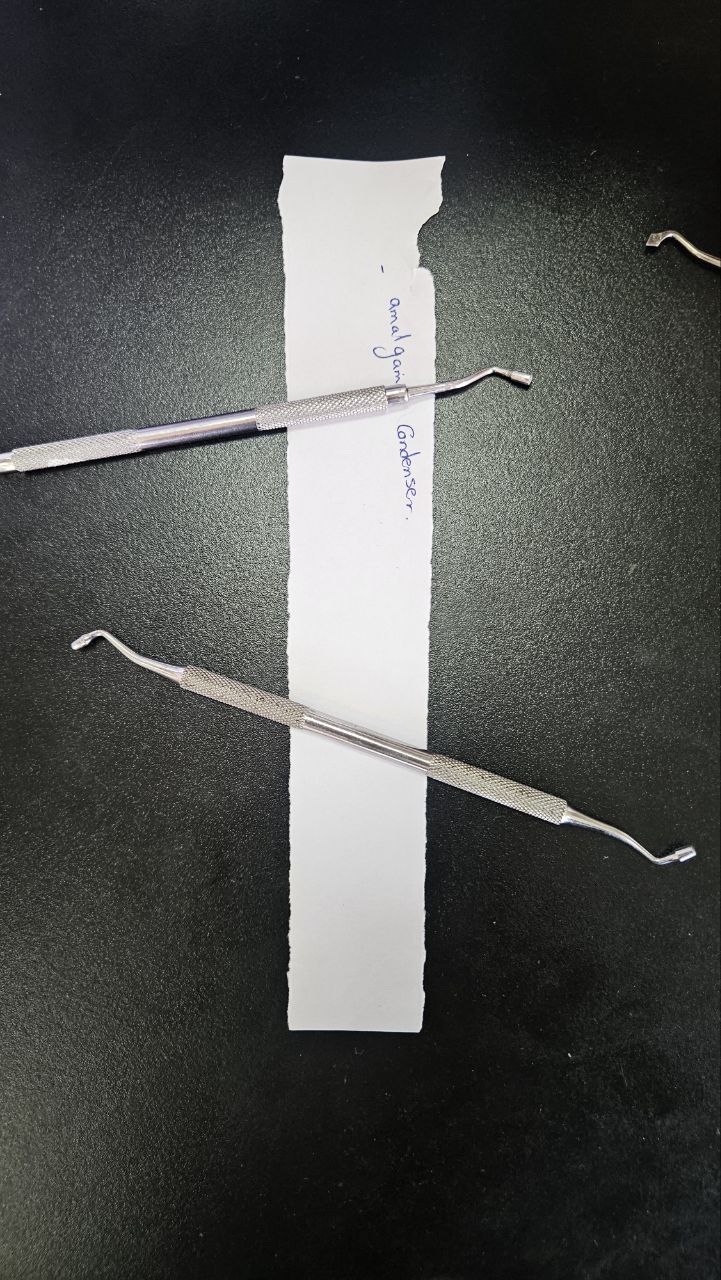
Amalgam condenser
Usage:
Used to pack and compress the amalgam tightly into the cavity.
Eliminates voids and increases the strength of the restoration.
How to Recognize Its Shape:
It has a solid, flat or slightly rounded tip (no hollow).
Straight or slightly angled handle.
Different tip sizes (small tip for small areas, bigger tip for large areas).

Amalgam burnisher
Usage:
Used to smooth, polish, and shape the surface of freshly packed amalgam.
Helps adapt the amalgam better to the cavity margins and make it shiny.
How to Recognize Its Shape:
It has a smooth, rounded, ball-shaped or football-shaped tip.
No sharp edges — looks like a smooth sphere or oval at the end.
Designed for gliding over the surface, not pressing hard.
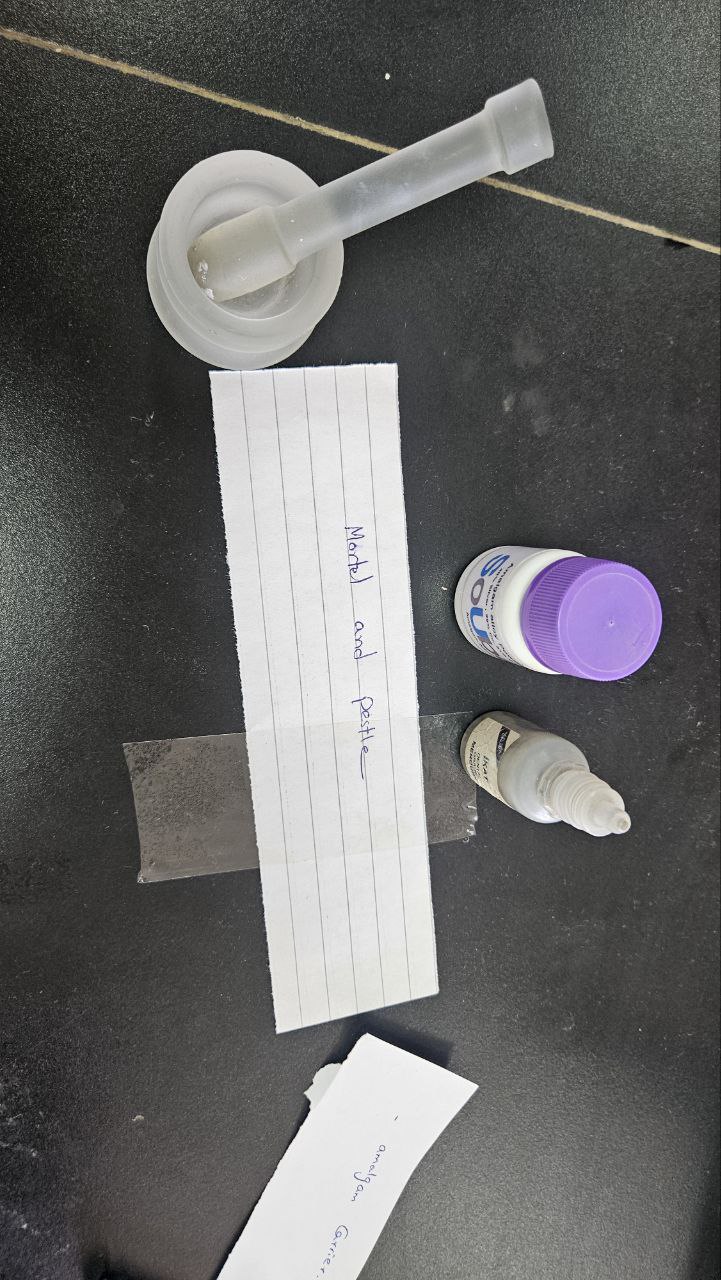
Motel and pestle
Usage:
Used to manually triturate (mix) amalgam by grinding mercury and alloy powder together.
Advantages:
Full manual control over mixing consistency.
Useful when a mechanical amalgamator is not available.
Allows small batches to be mixed precisely.
Disadvantages:
Time-consuming compared to mechanical trituration.
Hard to achieve uniform mixing — risk of improper amalgam properties (voids, weak structure).
Increased risk of mercury exposure to the operator.
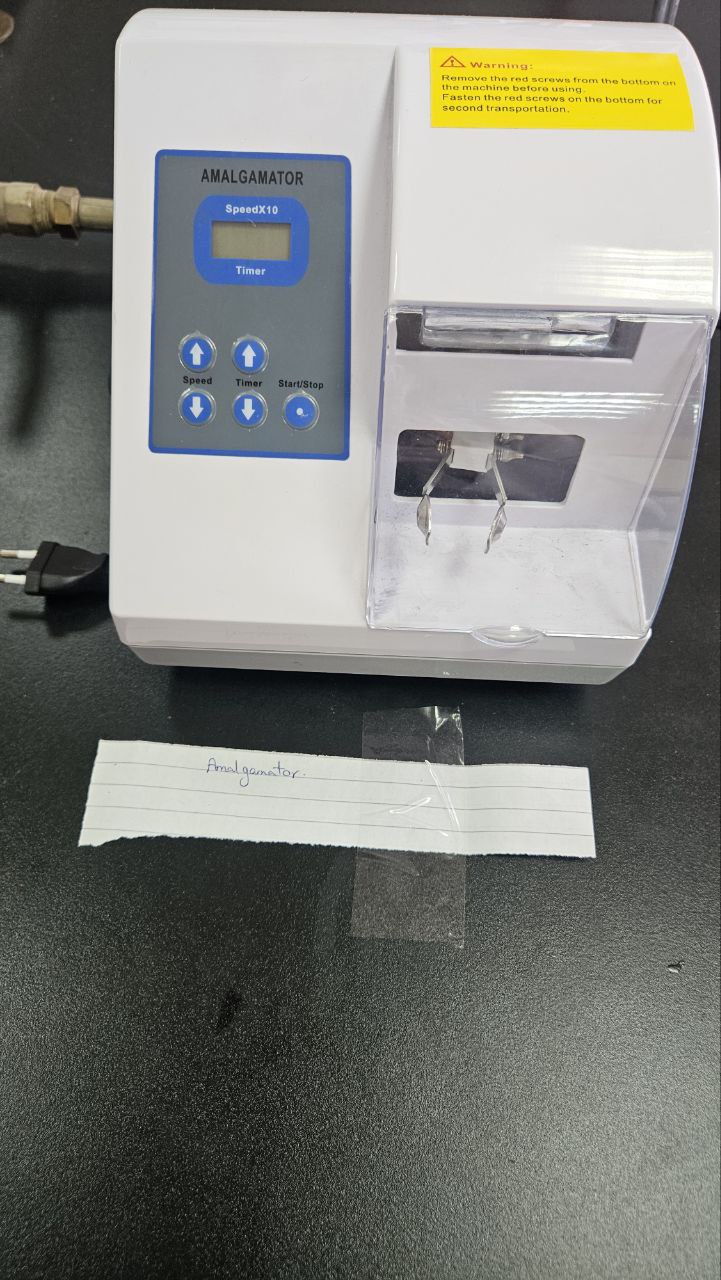
Amalgamator
A mechanical device used to mix (triturate) amalgam capsules automatically and uniformly.
Advantages:
Produces a uniform, consistent mix every time.
Faster than manual mixing (only takes a few seconds).
Reduces mercury exposure compared to mortar and pestle.
Disadvantages:
Needs electricity to operate.
Machine cost (initial purchase is expensive compared to manual tools).
Wrong setting (too fast or too slow) can lead to over-trituration or under-trituration.
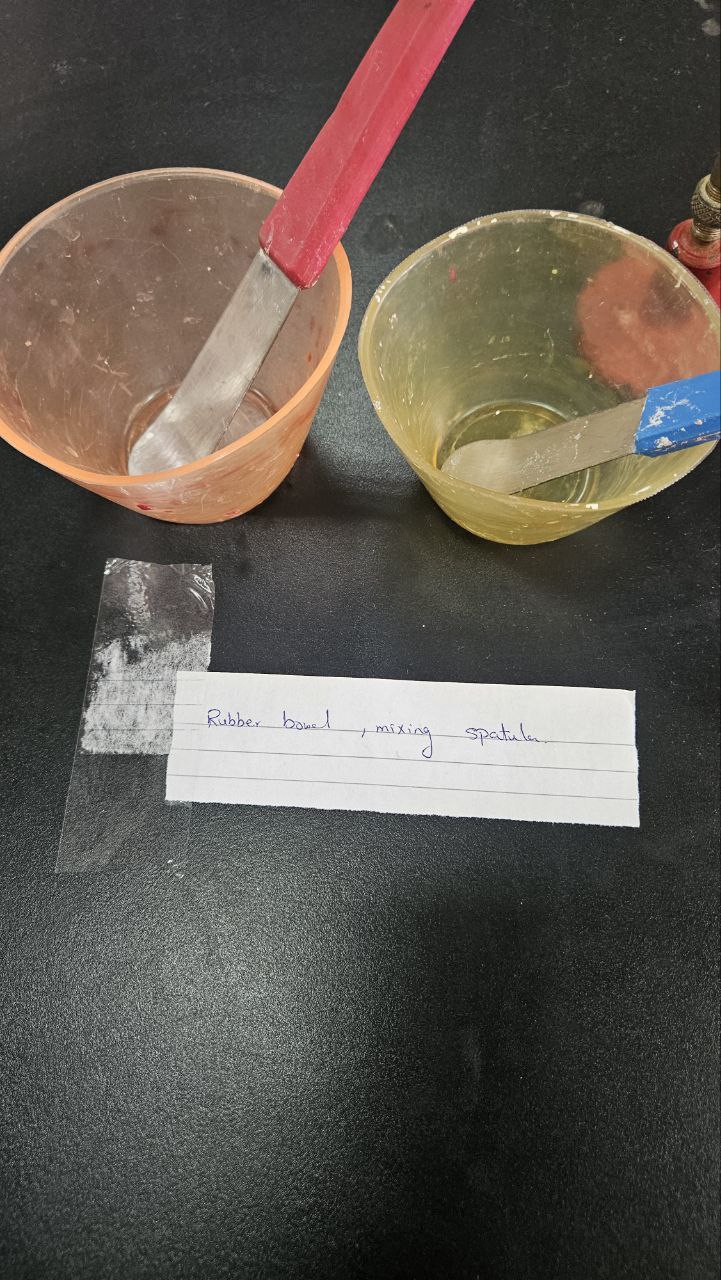
Rubber bowel,mixing spatula
Rubber bowl and metal spatula are the tools used for hand mixing alginate impression material .
They are part of the equipment needed for alginate manipulation, along with the perforated or rim-locked stock tray .
Important notes:
Rubber bowl is flexible, which helps in easily mixing and scraping the material.
Metal spatula is strong enough to properly incorporate powder and liquid together, ensuring a homogenous mix.
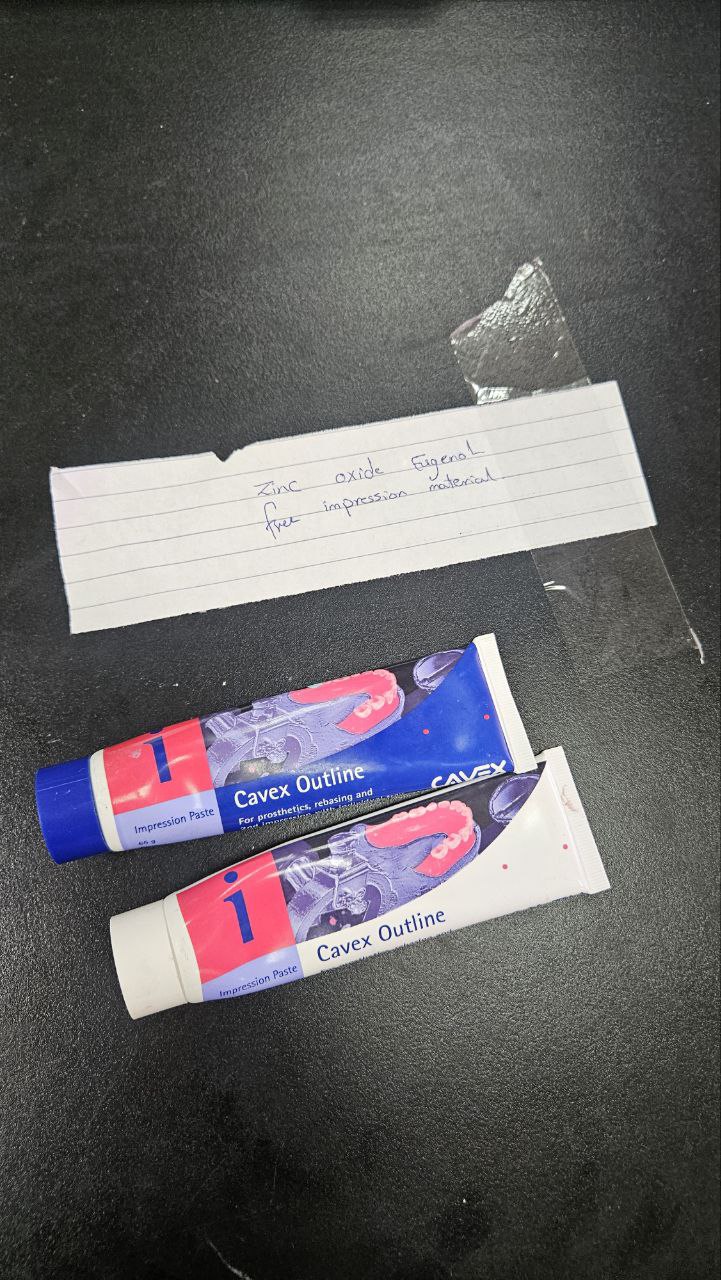
Zinc oxide euginol free impression material
Unique Points:
It is a modification of regular Zinc Oxide Eugenol (ZOE) impression material where eugenol is removed to avoid irritation to oral tissues.
It replaces eugenol with non-eugenol materials (like carboxylic acids) that react with zinc oxide to form the set material.
It is specifically used for patients sensitive to eugenol and provides a less irritating alternative.
Uses:
Secondary (final) impressions for edentulous patients (no teeth).
When a non-irritant impression material is needed for mucosal tissues.
Useful in cases where regular ZOE would cause burning or allergic reactions.
Properties:
Flowable enough to record fine details.
Rigid after setting, allowing for accurate transfer of soft tissue relationships.
Dimensionally stable if properly handled.
Advantages:
No burning sensation (compared to regular ZOE).
Better tissue tolerance for sensitive patients.
Good surface detail reproduction.
Disadvantages:
Brittle after setting → can fracture if not handled carefully.
Cannot be used where undercuts are present (because it is rigid).
Short working time (depending on formulation).
Reaction Name:
Acid-base reaction (between zinc oxide and non-eugenol acid derivative).
Manipulation:
Mixed manually using two pastes (base and accelerator).
Mixing is done on an oil-impermeable paper pad using a spatula until uniform color is achieved.
Should be loaded quickly into the tray and seated in the mouth before setting starts.
Unique/Important Points:
Designed for hypersensitive patients (who react to eugenol).
Setting can be influenced by temperature and humidity (higher temperature = faster set).
Should avoid using on deep undercuts because removal may damage tissues or material.
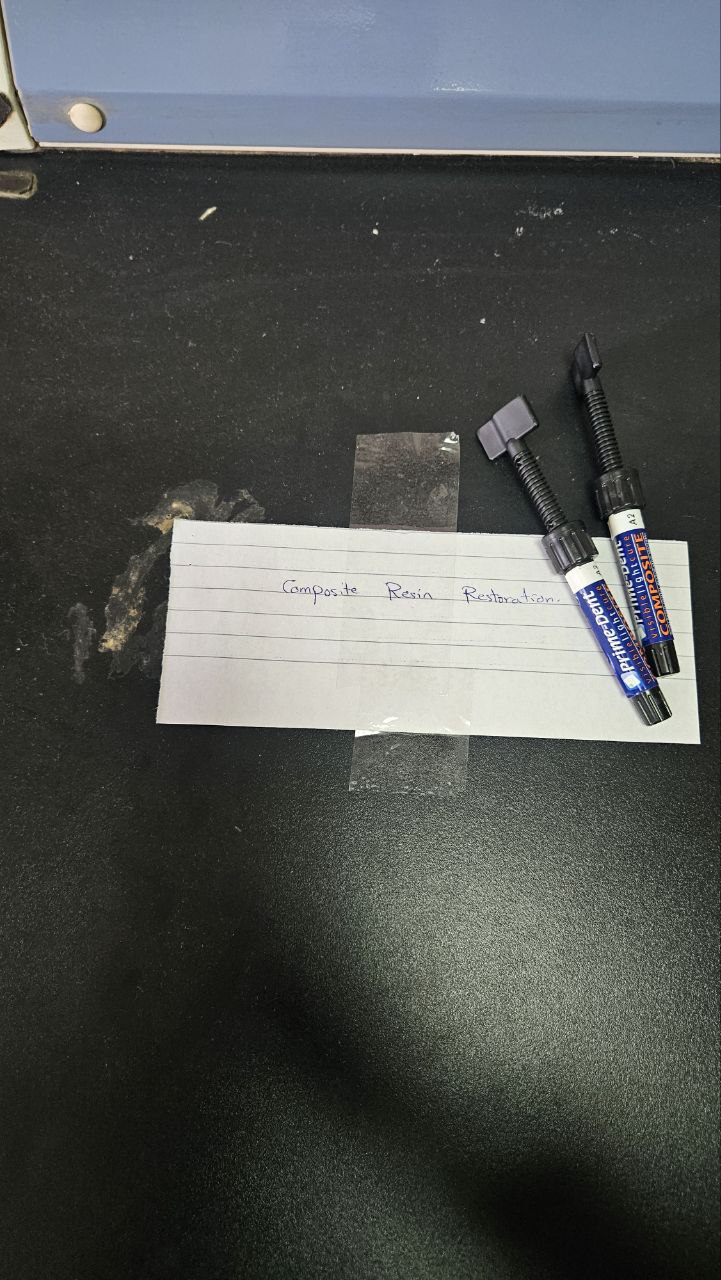
Composite resin restoration
Composite resin is made of two parts: a plastic resin and hard fillers.
It needs acid etching to stick to teeth (it doesn’t bond chemically).
It hardens either by light or by a chemical reaction.
Uses:
Filling cavities in front teeth and some back teeth.
Changing tooth shape or color.
Cosmetic repairs.
Properties:
Strong but can shrink a little while hardening.
Good appearance like natural teeth.
Not irritating to tissues.
Advantages:
Looks natural.
Safe for the tooth.
Good resistance to wear.
Disadvantages:
Shrinkage can cause small gaps.
Needs careful technique.
Can sometimes cause sensitivity if not done well.
Reaction Name:
Free radical polymerization.
Manipulation:
Clean and prepare the tooth.
Etch the tooth with acid.
Apply bonding agent.
Place composite in small layers and cure each layer with light.
Finish and polish after hardening.
Unique/Important Points:
Fillers make the composite stronger and prettier.
Different types exist depending on filler size (for strength and polishability).
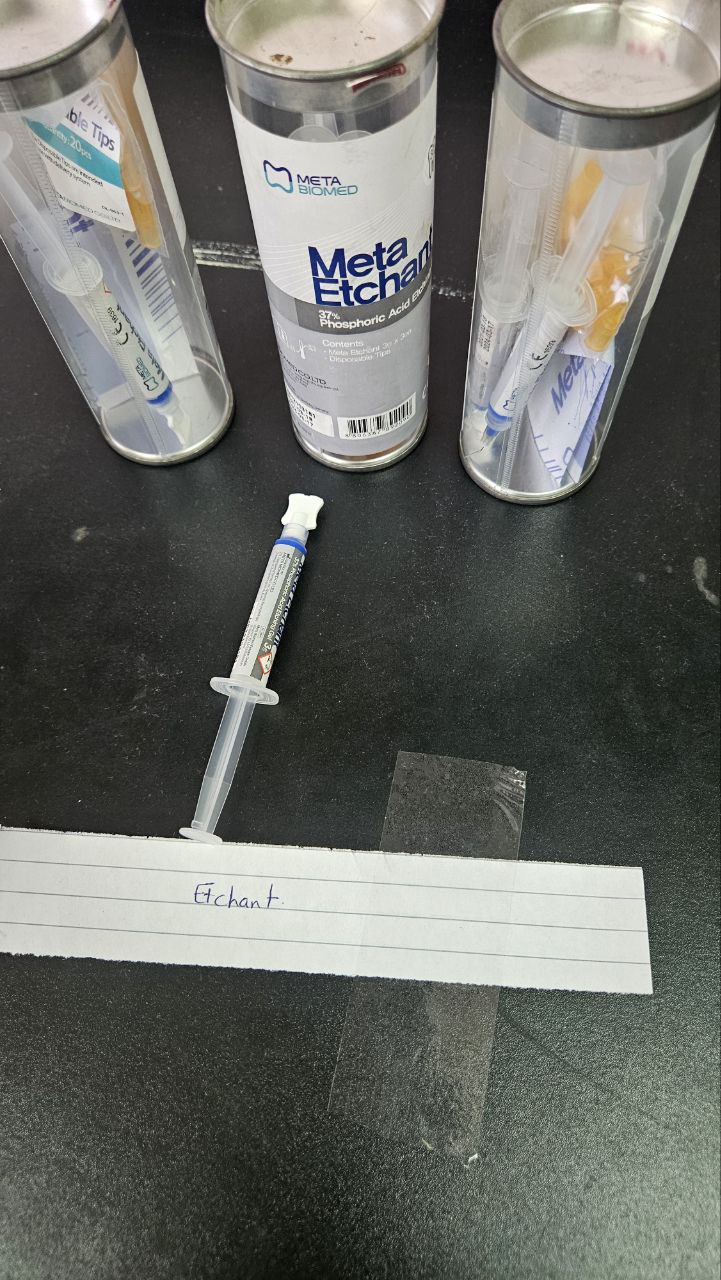
Etchant
Unique Points:
Etchant is usually an acid used to make the tooth surface rough.
It helps bonding agents stick better.
Mostly used on enamel and dentin.
Uses:
Prepare the tooth for bonding.
Improve adhesion of composite fillings and sealants.
Properties:
Makes tooth surface microporous (tiny holes).
Increases surface energy so bonding agents spread better.
Needs to be washed off after applying.
Advantages:
Stronger bond between tooth and filling.
Better sealing of the filling.
Helps prevent microleakage.
Disadvantages:
Over-etching can weaken the tooth.
If not handled properly, can cause sensitivity.
Reaction Name:
No special reaction name, just acid demineralization.
Manipulation:
Apply etchant on the tooth (usually 15-20 seconds).
Rinse it off well with water.
Dry gently without over-drying (especially for dentin).
Unique/Important Points:
Most common etchant is phosphoric acid (about 35%-37%).
After etching, enamel looks frosty or chalky.
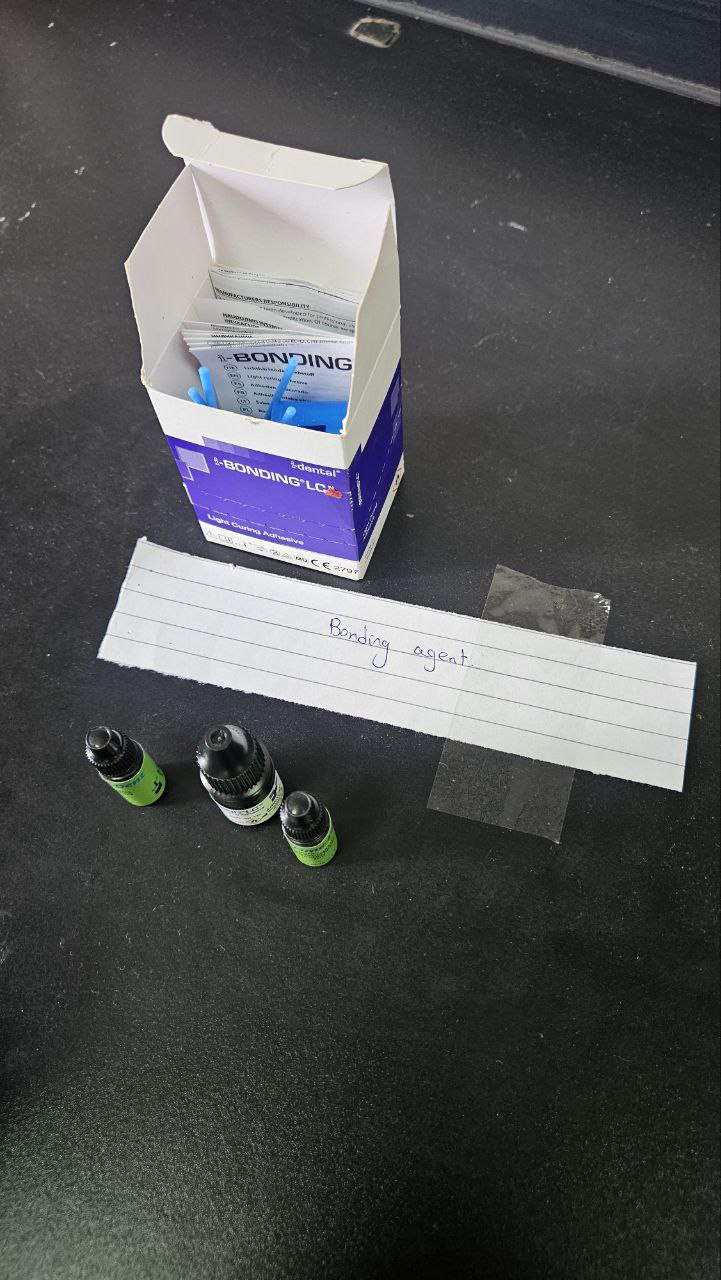
Bonding agent
3 Unique Points:
Bonding agent is used to connect the filling to the tooth.
It works between hydrophilic tooth and hydrophobic filling.
It is made of primer and adhesive, and sometimes an etchant.
Uses:
Bond composite to enamel and dentin.
Used with sealants, crowns, and veneers.
Properties:
Makes the bond strong and durable.
Forms a hybrid layer that sticks tightly to dentin.
Needs a moist tooth surface for good bonding (especially dentin).
Advantages:
Stronger restoration.
Less leakage.
More lasting fillings.
Disadvantages:
If done wrong, can cause sensitivity.
Some types are more technique sensitive than others.
Reaction Name:
Mainly micromechanical bonding and resin infiltration.
Manipulation:
Etch → prime → bond (depends if it’s total-etch or self-etch).
Apply with a brush or applicator.
Light cure after application.
Unique/Important Points:
Acid etching creates small pores that bonding agent fills in.
Hybrid layer is key for strong dentin bonding.
How to know the bonding type (based on bottles you see):
3 bottles = 4th generation (etch, primer, adhesive separate).
2 bottles = 5th or 6th generation (etch separate, primer+bond together OR primer+adhesive together).
1 bottle = 7th or 8th generation (everything mixed together, just one step).
In short:
3 bottles → 4th gen
2 bottles → 5th or 6th gen
1 bottle → 7th or 8th gen
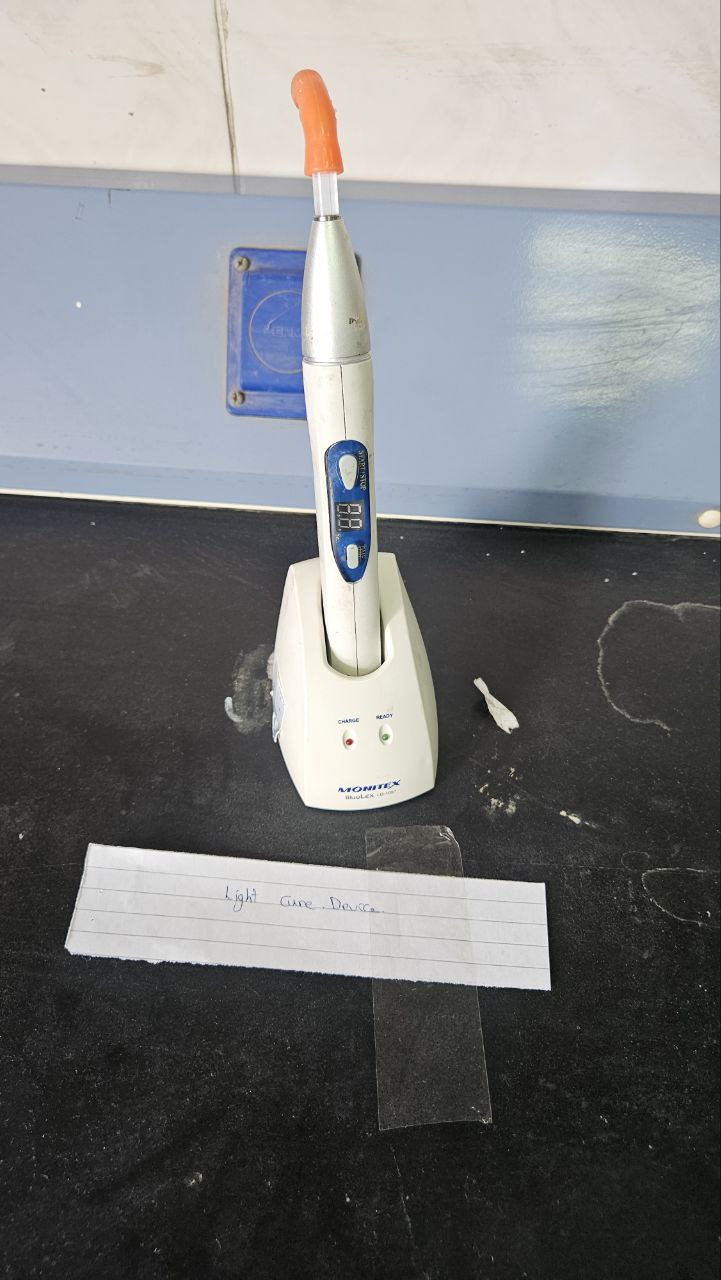
Light cure device
Emits blue light to harden composite.
Activates the setting reaction.
Lets you control when material sets.
Uses:
Hardening composites and bonding agents.
Properties:
Blue light, needs to be close to material.
Advantages:
Easy to use.
Controlled working time.
Disadvantages:
Weak bond if not used properly.
Risk of overheating if misused.
Reaction Name:
Photo-polymerization.
Manipulation:
Hold close, cure each layer properly.
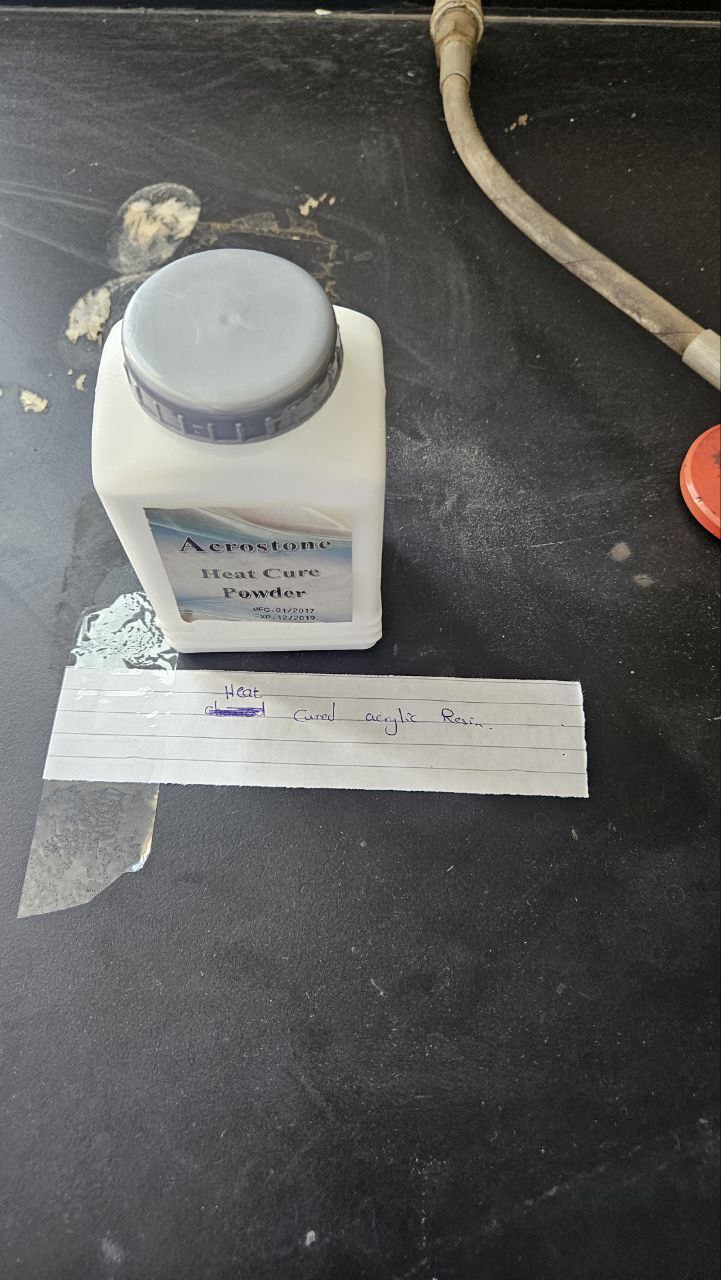
Heat cured acrylic resin
Used mainly for dentures.
Hardens by heat activation.
Made from powder and liquid mix.
Uses:
Denture bases.
Orthodontic appliances.
Properties:
Strong and stable.
Needs high temperature to set.
Advantages:
Good strength.
Good fit for dentures.
Disadvantages:
Shrinkage during processing.
Takes longer time to prepare.
Reaction Name:
Free radical polymerization.
Manipulation:
Mix powder and liquid → pack → heat cure.
Unique/Important Points:
Pressure and temperature must be controlled during curing.
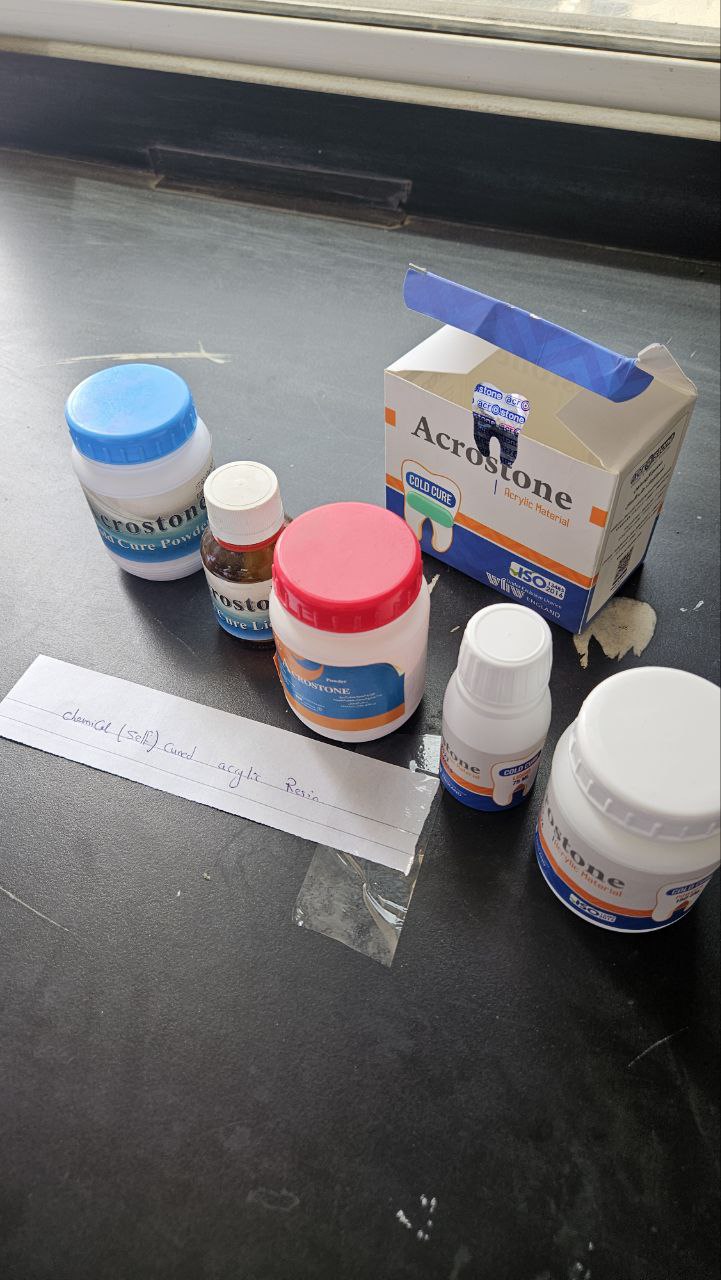
Chemical (self)cured acrylic resin
3 Unique Points:
Hardens by a chemical reaction without heat.
Also called self-cured or cold-cured resin.
Used when fast setting is needed.
Uses:
Temporary dentures.
Repairing broken dentures.
Properties:
Sets at room temperature.
Lower strength than heat-cured acrylic.
Advantages:
Faster and easier to use.
No need for special heating equipment.
Disadvantages:
More porosity.
Weaker and less color stable.
Reaction Name:
Free radical polymerization (initiated chemically).
Manipulation:
Mix powder and liquid → pack → allow to set at room temperature.
Unique/Important Points:
Commonly used for repairs and temporary work, not for final dentures.
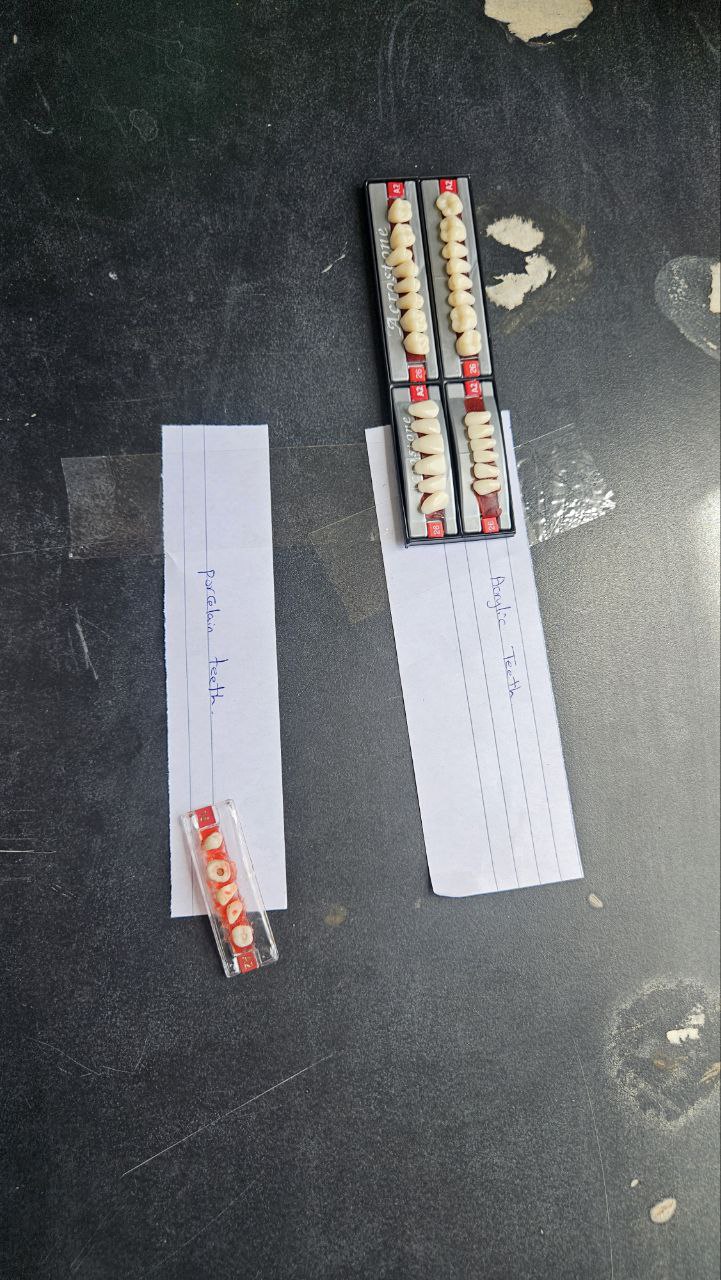
Acrylic teeth and porcelain teeth
Unique Points:
Made from acrylic resin.
Bond easily to denture bases.
Less wear resistant than porcelain teeth.
Uses:
Artificial teeth for dentures.
Temporary teeth in prosthodontics.
Properties:
Lightweight and easily adjustable.
Good esthetics but softer than porcelain.
Advantages:
Easier to adjust and polish.
Better bond with denture base.
Less risk of breaking compared to porcelain.
Disadvantages:
Wear down faster.
Scratch easily.
Reaction Name:
Based on polymerization of acrylic resin.
Manipulation:
Selected and arranged manually on denture base.
Unique/Important Points:
Common choice when cost, bonding, and repair are important.
Porcelain teeth (have a dot at the back)
Unique Points:
Made from ceramic material.
Very hard and wear-resistant.
Do not bond chemically to denture base (need mechanical retention).
Uses:
Artificial teeth for dentures.
For patients needing high esthetics and durability.
Properties:
Strong and resistant to wear.
More brittle than acrylic teeth.
Advantages:
Excellent esthetics (looks like natural enamel).
Highly resistant to wear and stains.
Disadvantages:
Can fracture easily.
Heavier and may cause clicking sound.
Reaction Name:
Sintering (firing ceramic particles together).
Manipulation:
Selected, arranged, and attached mechanically to denture base.
Unique/Important Points:
Need retention pins or roughening to attach properly to denture.
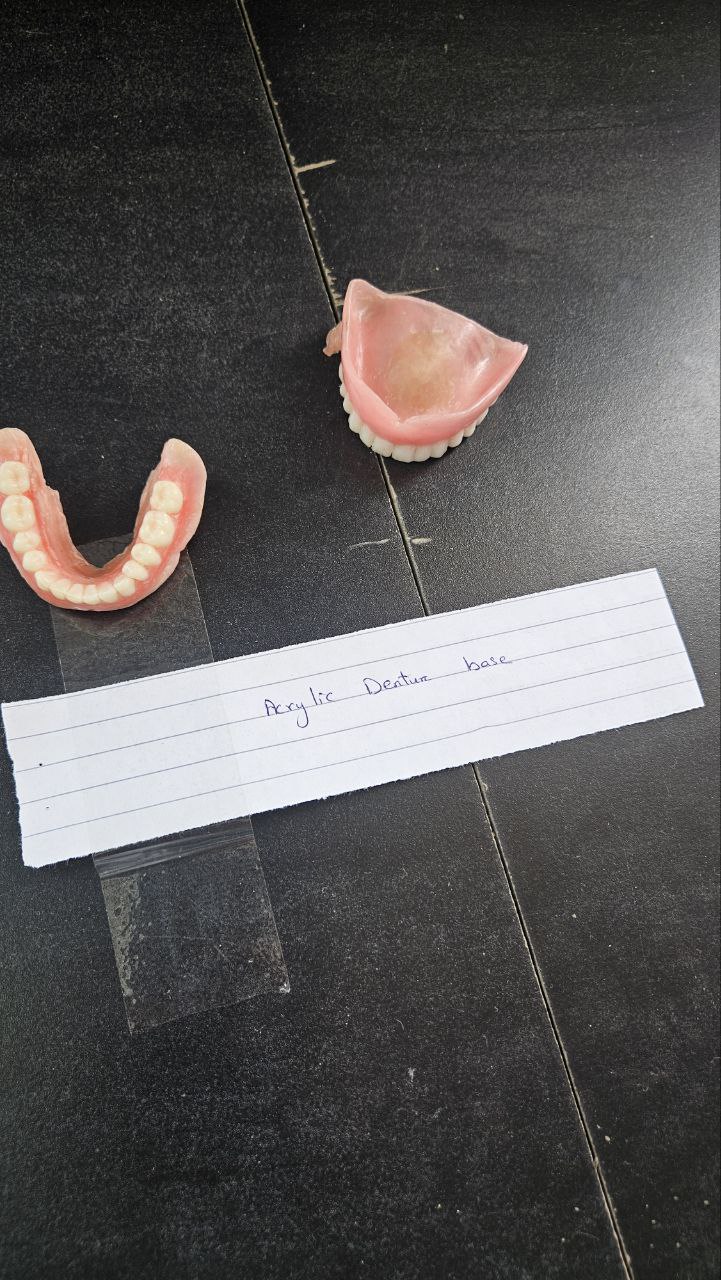
Acrylic denture base
Unique Points:
Made mainly from Polymethyl Methacrylate (PMMA).
Forms the bulk of complete or partial denture bases.
Can be heat-cured or chemically (self)-cured.
Uses:
Used as denture base material to support artificial teeth.
For repair of broken dentures.
Used in making special trays.
Properties:
Good esthetic appearance (pink like gums).
Low thermal conductivity (protects oral tissues).
Moderate strength, but brittle under impact.
Advantages:
Easy to fabricate and adjust.
Good esthetics (matches gum color).
Inexpensive compared to metal bases.
Disadvantages:
Brittle, can fracture if dropped.
Low impact strength.
Porosity if processing is improper.
Name of Reaction (if mentioned):
Addition polymerization (Free radical type).
Manipulation:
Mixing powder and liquid (monomer and polymer).
Packing into molds during dough stage.
Polymerization by heat or chemical curing.
Important Unique Notes:
Residual monomer may cause irritation if not fully cured.
Water sorption over time leads to slight dimensional changes.
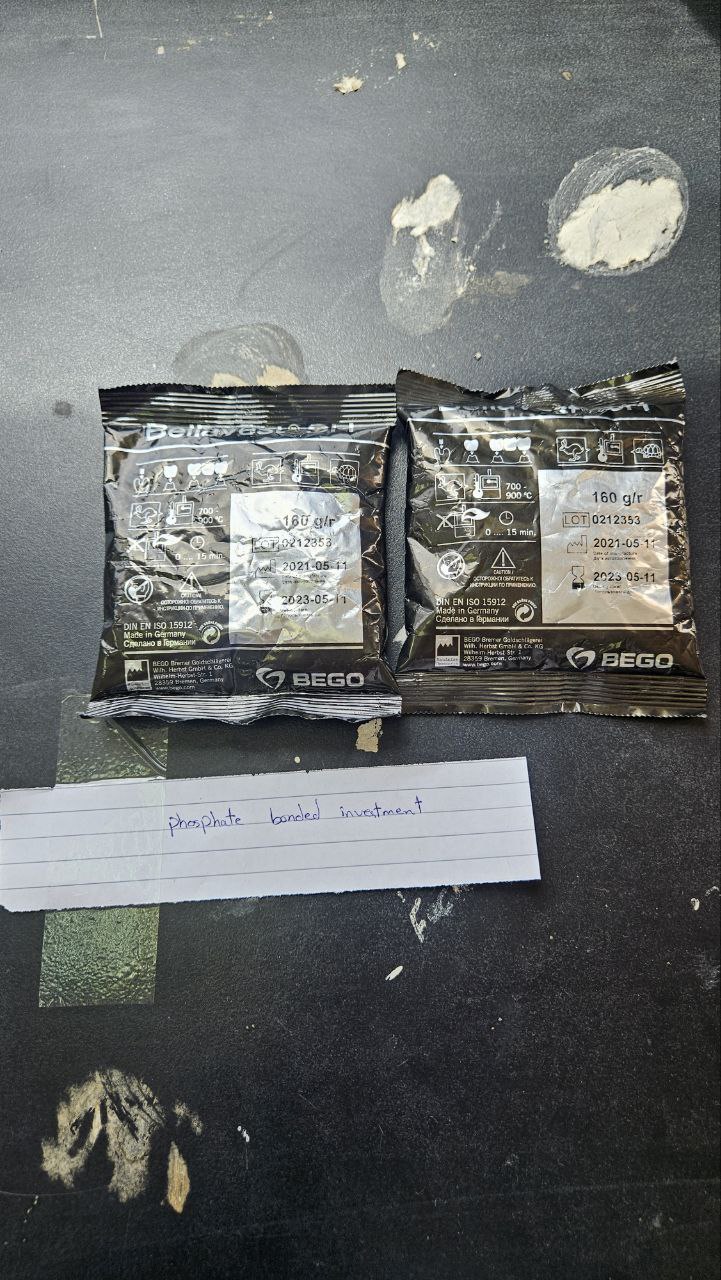
Phosphate bonded investment
Unique Points:
Used for high-temperature castings like metal-ceramic crowns.
Binds by chemical reaction between phosphate and silica.
Can withstand high temperatures without breaking down.
Uses:
For casting high-fusing alloys (like cobalt-chromium and nickel-chromium).
Used in ceramic work and metal frameworks.
Suitable for pressable ceramics.
Properties:
High strength and thermal stability.
Minimal setting and thermal expansion (compared to gypsum investment).
More brittle than gypsum investments.
Advantages:
Can withstand temperatures above 1000°C.
Compatible with alloys that need higher casting temperatures.
Good surface detail reproduction.
Disadvantages:
More expensive than gypsum investments.
Technique-sensitive (care needed with mixing and handling).
More difficult to remove after casting (harder de-flasking).
Name of Reaction (if mentioned):
Phosphate setting reaction:
(Ammonium phosphate + Magnesium oxide + Silica filler) → hard setting mass.
Manipulation:
Mix powder with liquid (special colloidal silica liquid preferred).
Vacuum mixing recommended to avoid air bubbles.
Careful burnout to avoid cracking.
Important Unique Notes:
Distance between wax pattern and end of casting ring is reduced to 4 mm when using phosphate bonded investment (compared to 6 mm in gypsum).
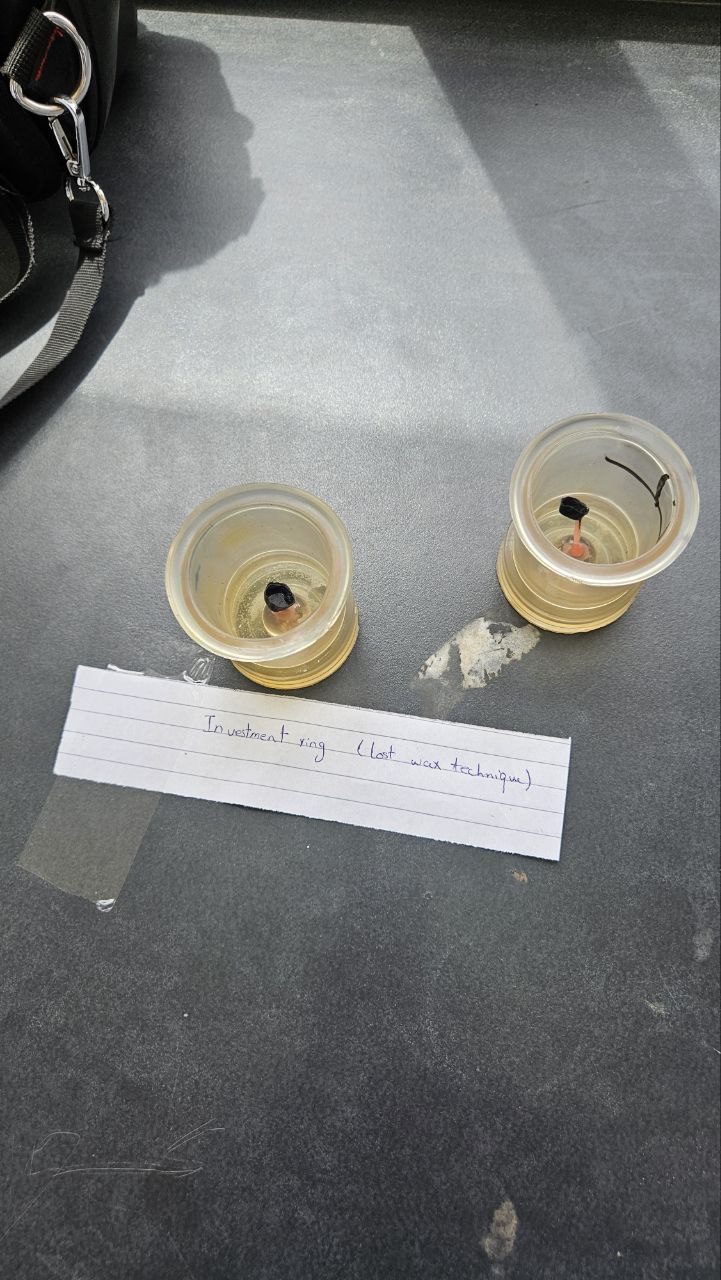
Investment ring (lost wax technique)
Uses:
To hold the wax pattern and investment material.
To create the mold for casting during the lost wax technique.
Liner is placed inside the ring to:
Allow lateral expansion of investment.
Prevent rapid cooling after burnout.
Permit easy separation of investment from ring.
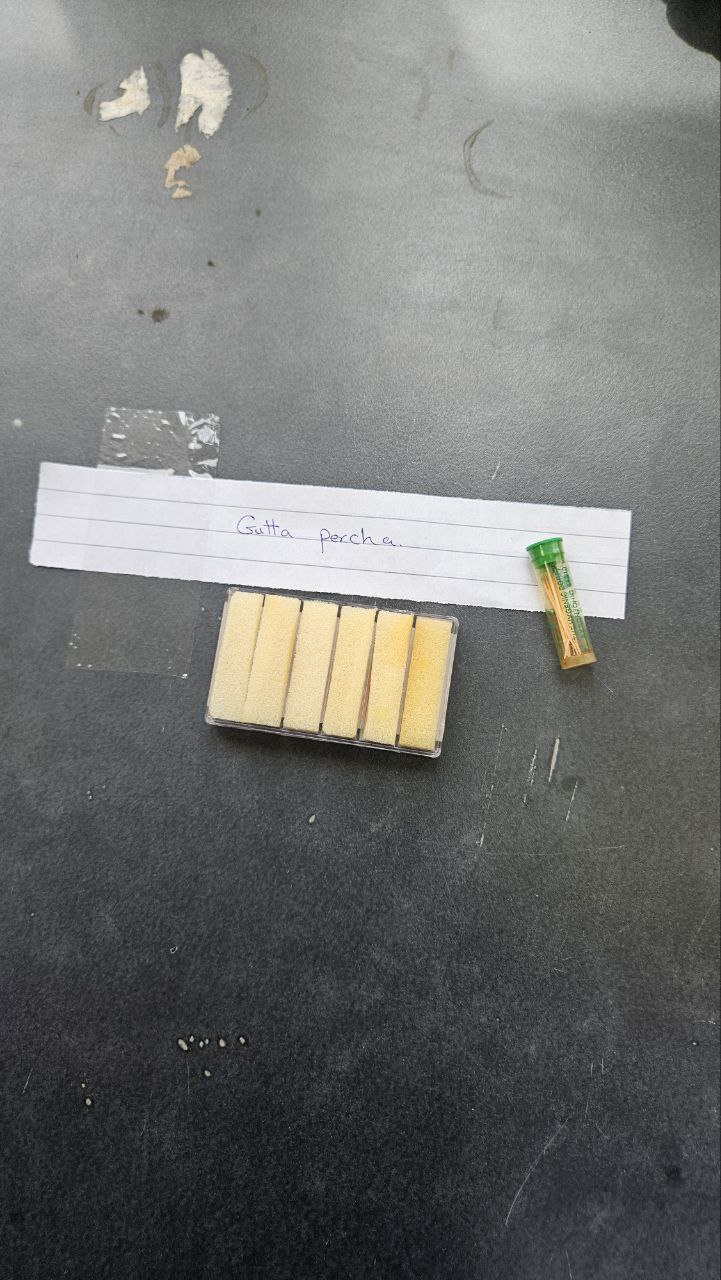
Gatta percha
Advantages:
Good adaptability.
Easy manipulation.
Easy removal.
Good biocompatibility.
Disadvantages:
Lack of adhesion to dentin.
Not flexible enough for severely curved canals.
Shrinkage.
Cannot be heat-sterilized (only disinfected with 5% NaOCl).
Oxidizes in air/light and becomes brittle (must be stored cool and dry).
Indications:
Used in most cases except severely curved/inaccessible canals.
Thermoplastic (softens when heated, hardens when cooled).
Insoluble in water.
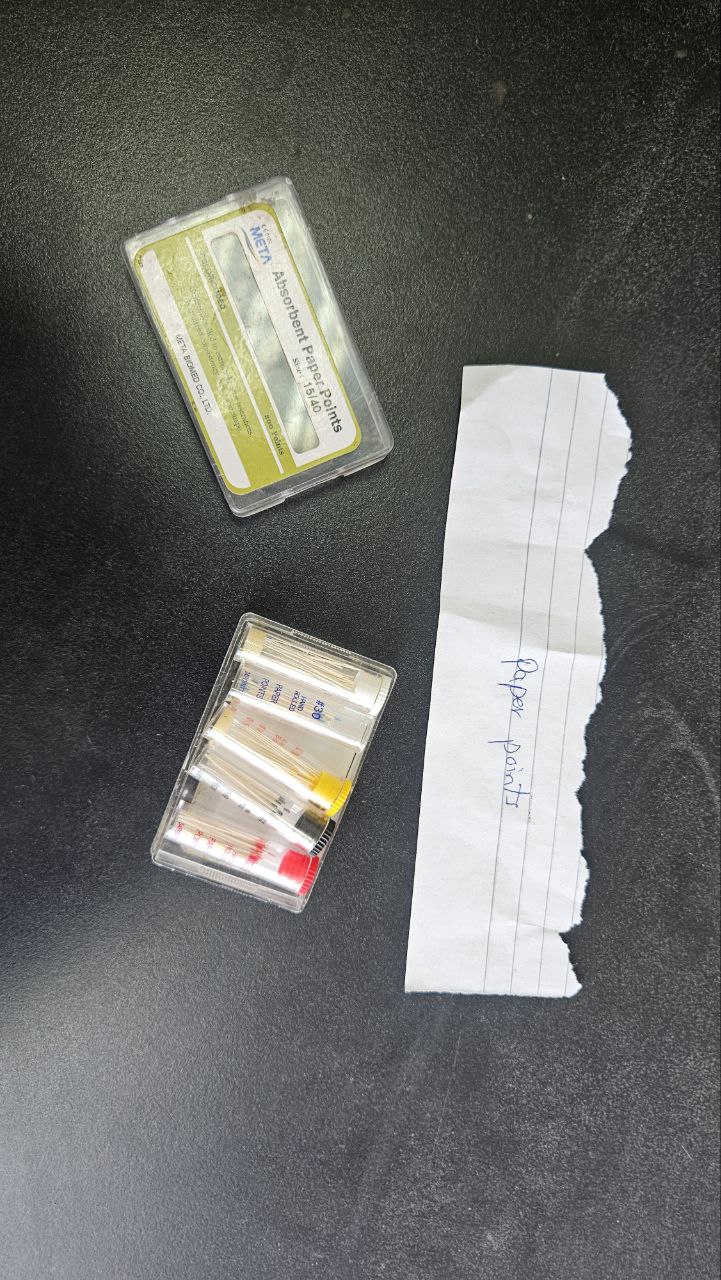
Paper points
Uses:
Drying the root canal before placing filling materials (like gutta-percha).
Applying intracanal medicaments.
Checking canal cleanliness (if paper points come out stained).
Properties:
Highly absorbent.
Sterile (single-use).
Soft and flexible (to avoid damaging canal walls).
Advantages:
Quick drying of canals.
Easy to use and inexpensive.
Available in various sizes and tapers.
Disadvantages:
Weak — can tear if used with too much force.
Single use only (cannot be reused).
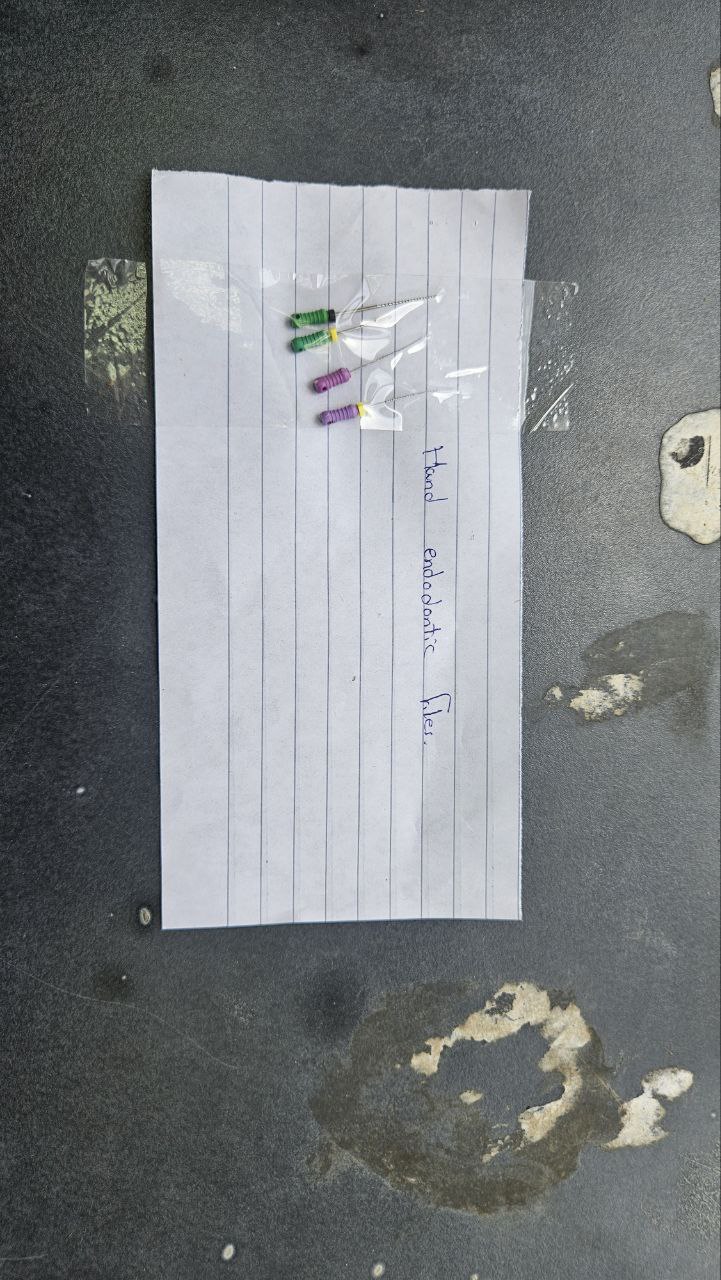
Hand endodontic file
Used for cleaning and shaping the root canal.
Files and reamers are tapered cutting tools.
Types by Material:
Carbon Steel:
High cutting efficiency, less corrosion resistance.
Stainless Steel:
Moderate cutting efficiency, better corrosion resistance.
Nickel-Titanium (NiTi):
Super elastic, most flexible, but least cutting efficiency.
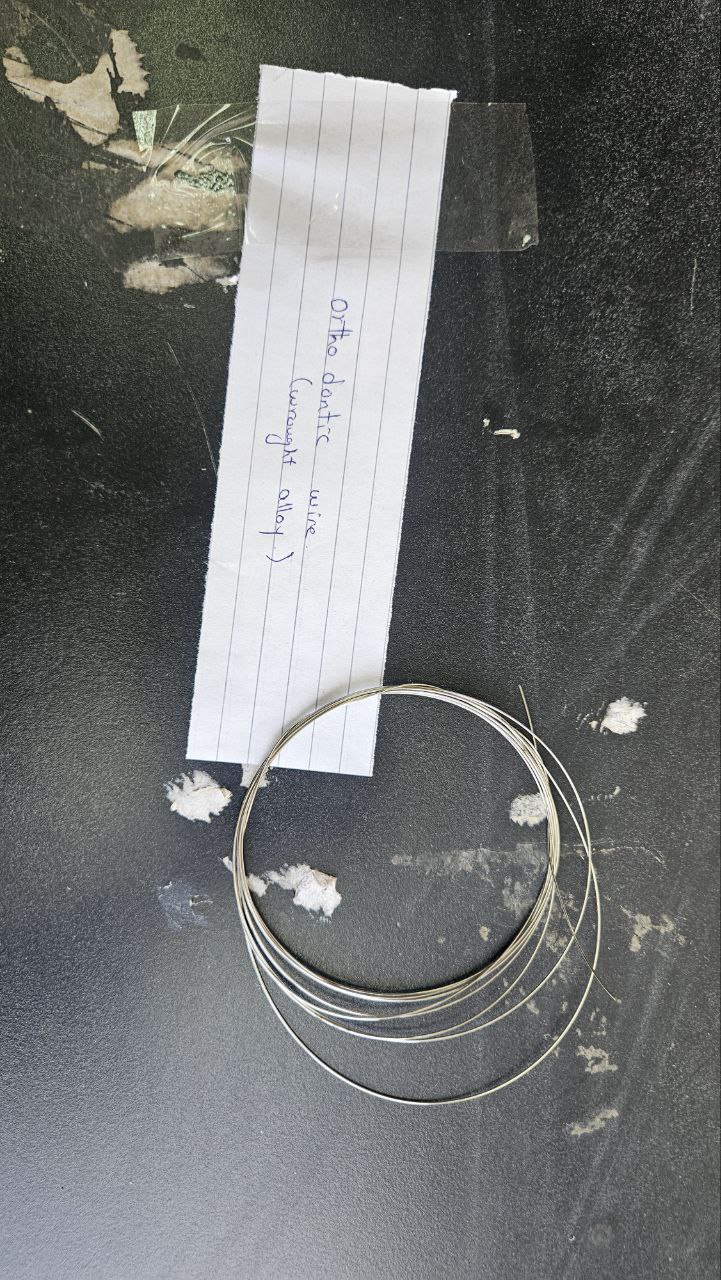
Orthodontic wire (wrought alloy)
Material:
Made from Wrought Alloys.
Uses (from the file):
Used as orthodontic wires for tooth movement.
Also used in partial denture clasps, endodontic files, surgical instruments, brackets, and prefabricated crowns.
Properties of Wrought Alloys (affect orthodontic wires):
Stronger and harder compared to their cast form.
Can be shaped and bent easily without fracturing.
Work-hardening occurs when they are manipulated (makes them even stronger but more brittle).
Advantages for Orthodontic Wires:
Good strength and flexibility.
Can be bent and adjusted during orthodontic treatment.
Disadvantages (related to Wrought Alloys):
Overworking (too much bending) can cause fracture (due to excessive work-hardening).
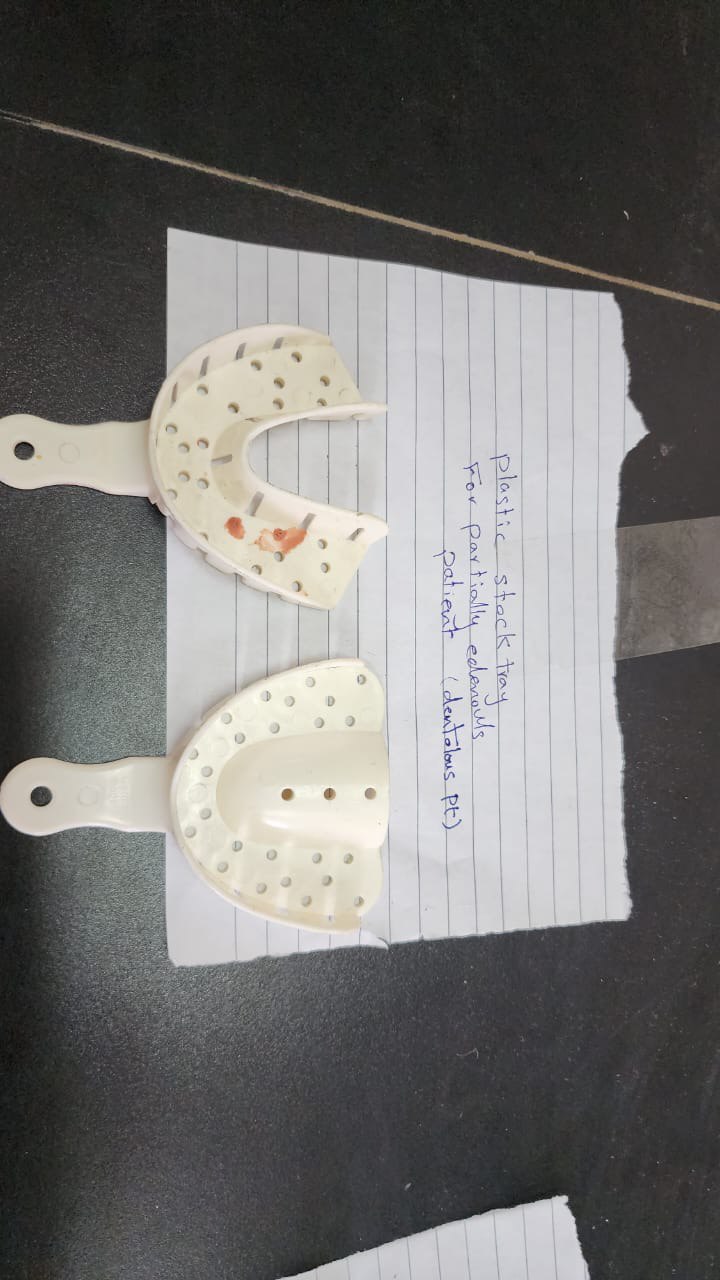
Plastic stock tray
For partially edentulous patient (dentulous)
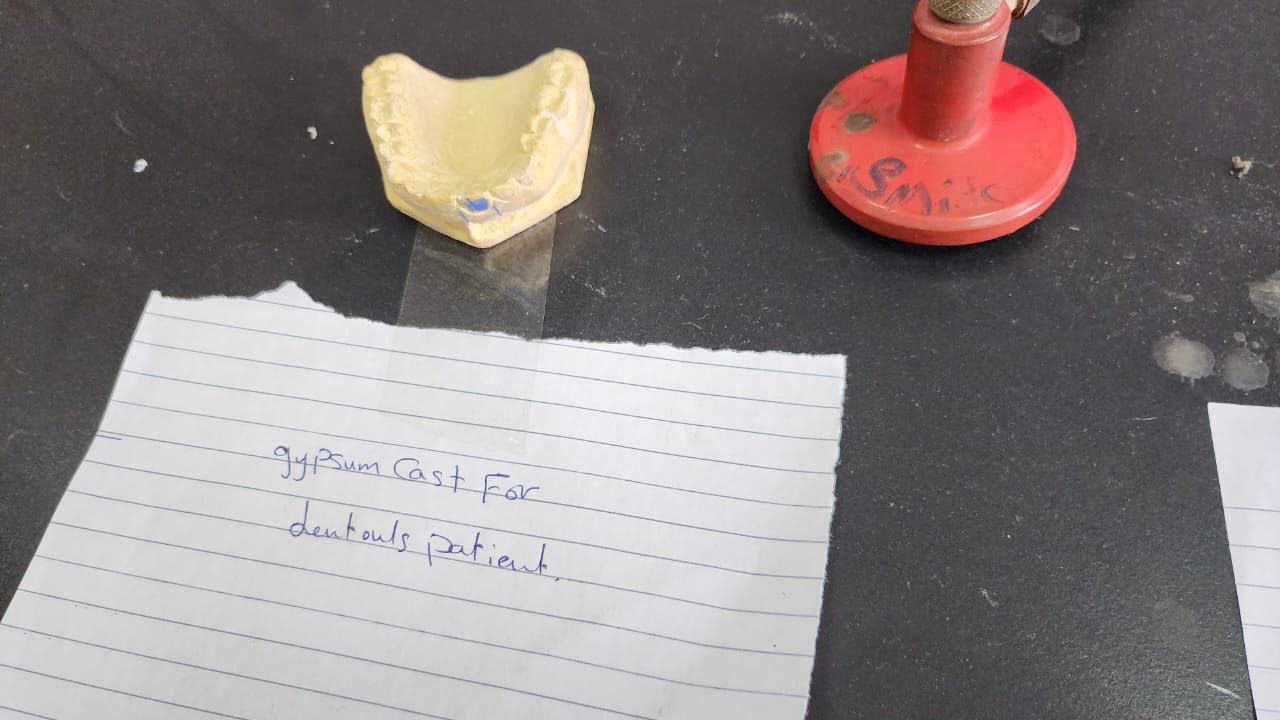
Gypsum cast for dentulous patient
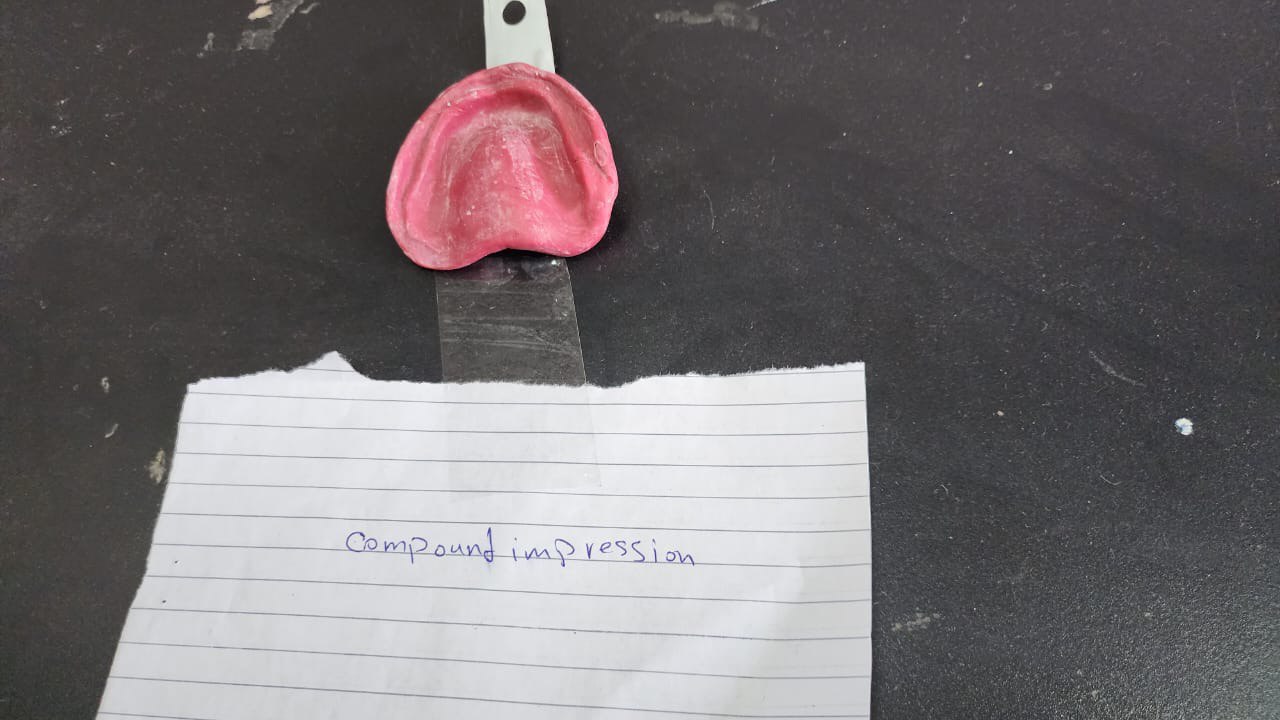
Compound impression
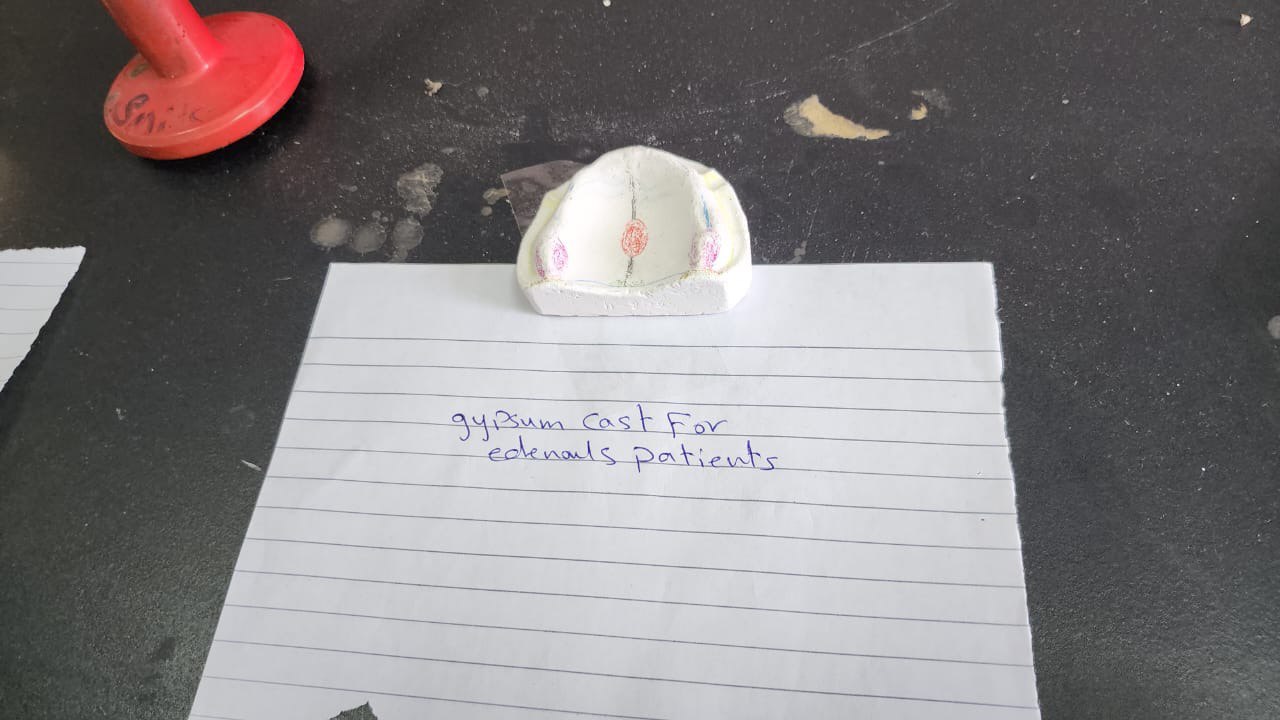
Gypsum cast for edentulous patients
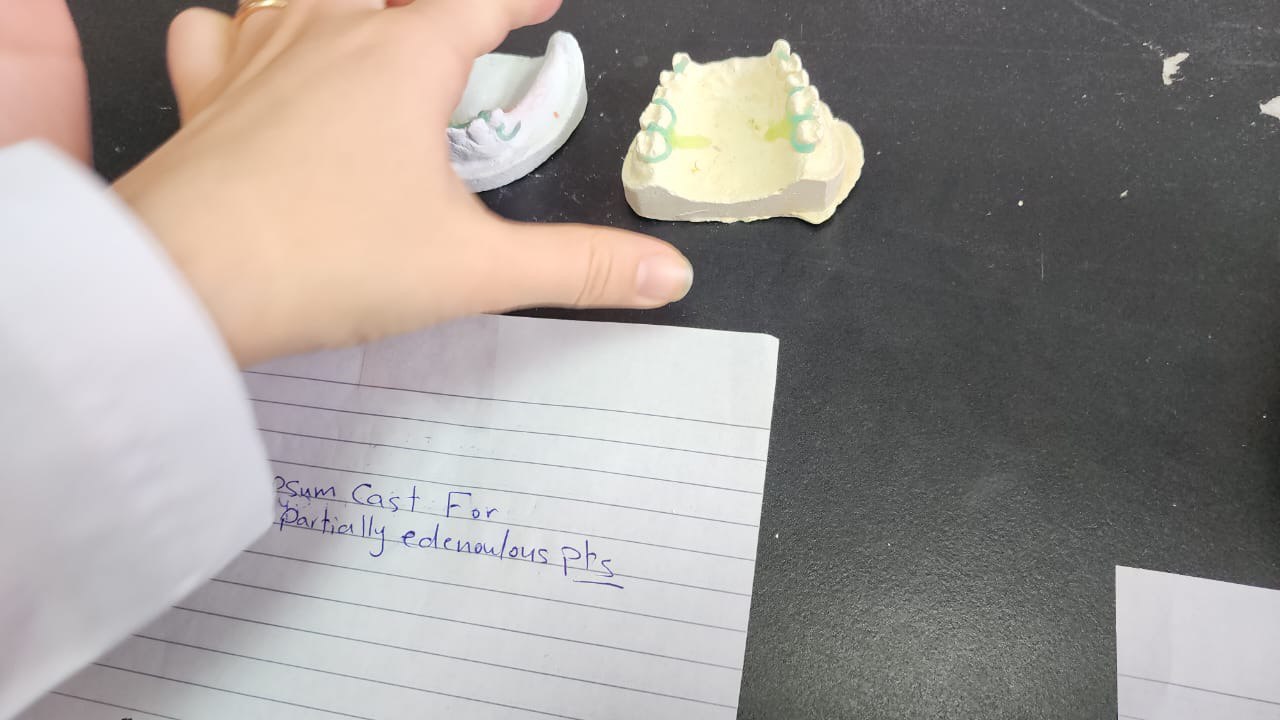
Gypsum cast for partially edentulous patients
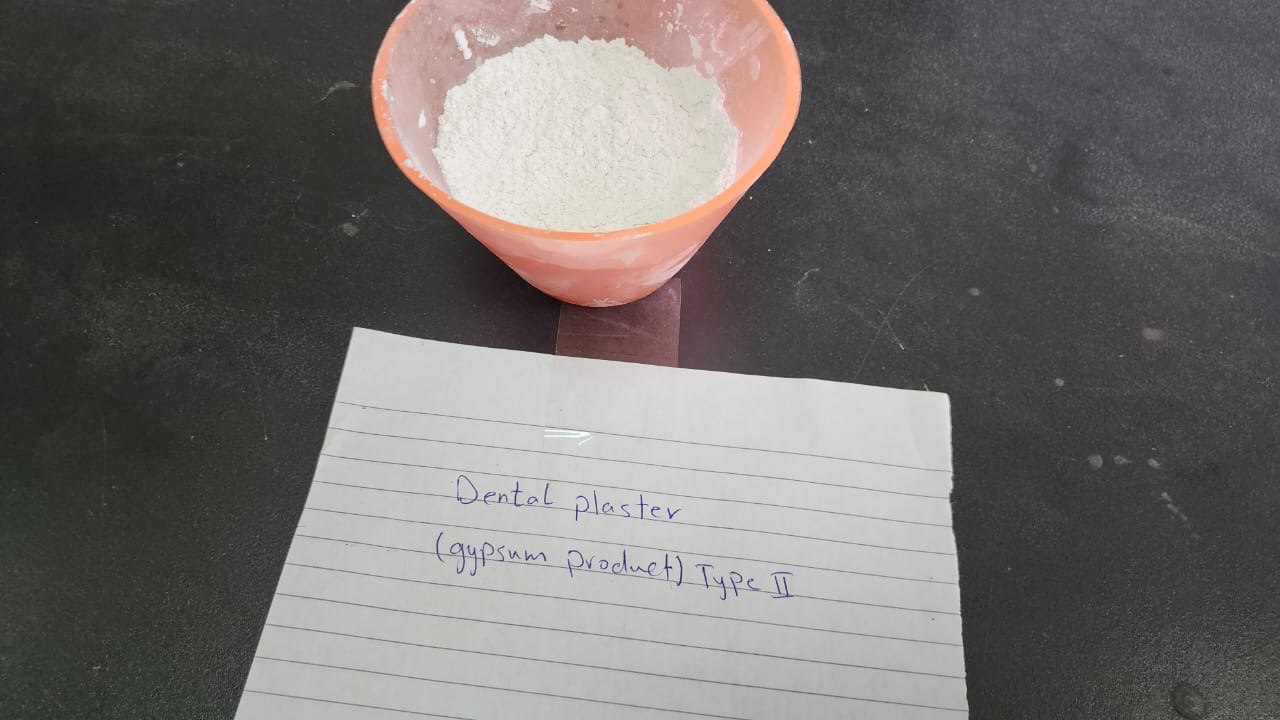
Dental plaster type 2 (gypsum product )
Uses:
Diagnostic casts.
Preliminary casts for complete dentures.
Orthodontic study models.
Properties:
Weakest and softest among gypsum products.
High porosity.
Fast setting compared to other types.
Advantages:
Easy to mix and pour.
Inexpensive.
Quick setting.
Disadvantages:
Low strength.
High water absorption.
Easily abraded or chipped.
Name of Reaction:
Calcination

Dental stone
Unique Points:
Dental Stone = Type III Gypsum Product.
Stronger and denser than Type II (Plaster).
Made by autoclave (wet) calcination of gypsum.
Uses:
Working casts for removable and fixed prosthodontics.
Study models when higher strength is needed.
Diagnostic casts.
Properties:
Higher strength and hardness compared to plaster.
Lower porosity.
Moderate setting time.
Advantages:
Good mechanical strength.
More abrasion resistant than plaster.
More accurate surface detail reproduction.
Disadvantages:
More expensive than plaster.
Needs more careful mixing (proper water/powder ratio).
Name of Reaction:
Calcination
These Flashcards Are Made By Buthaynah Alhareeri
Insta:drbuthaynah